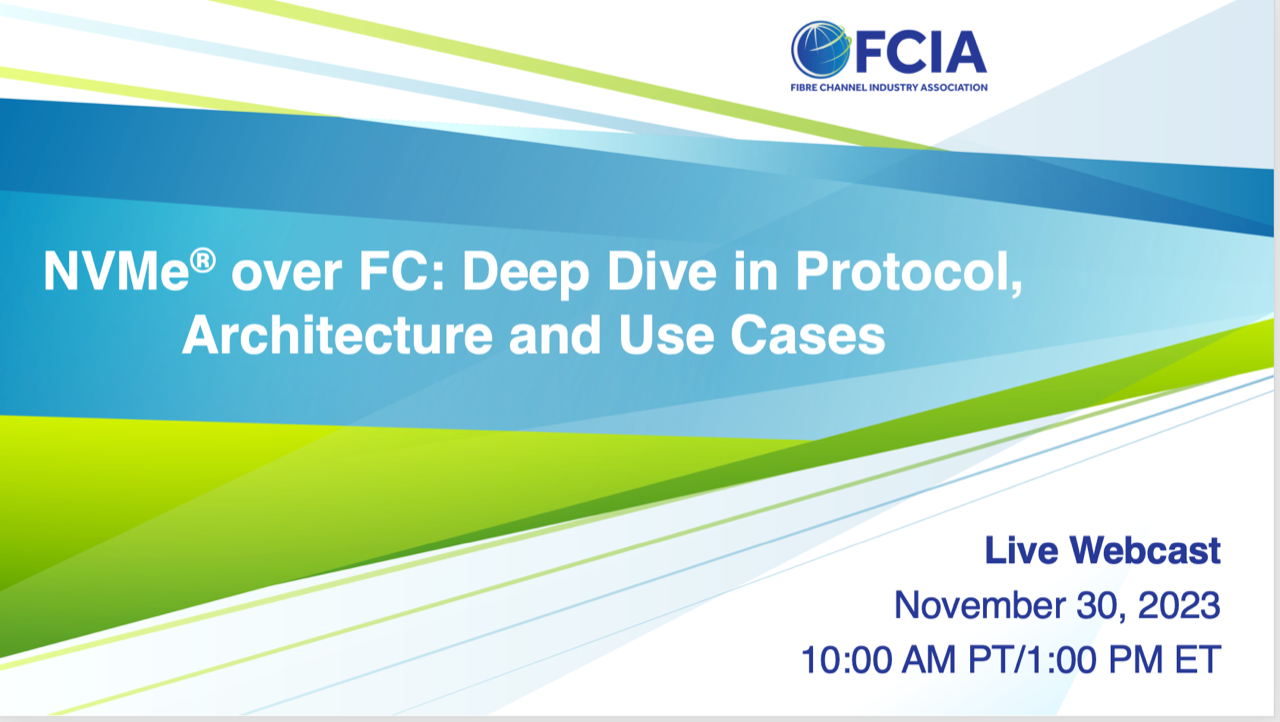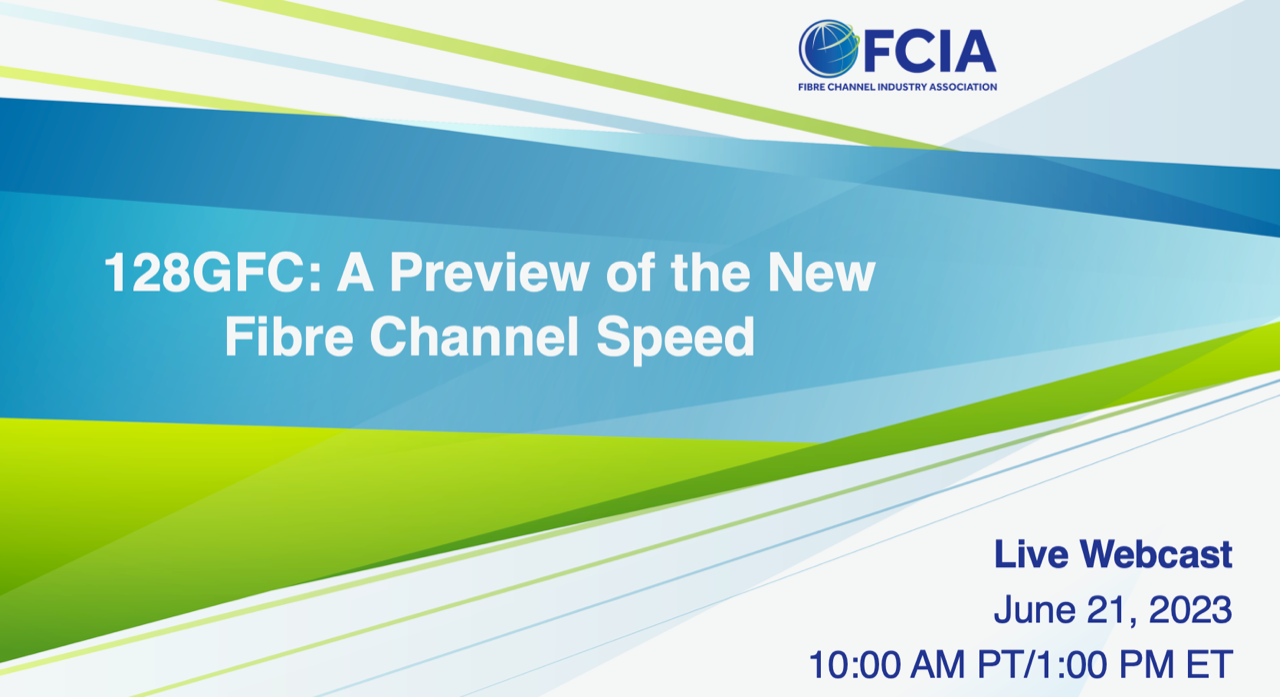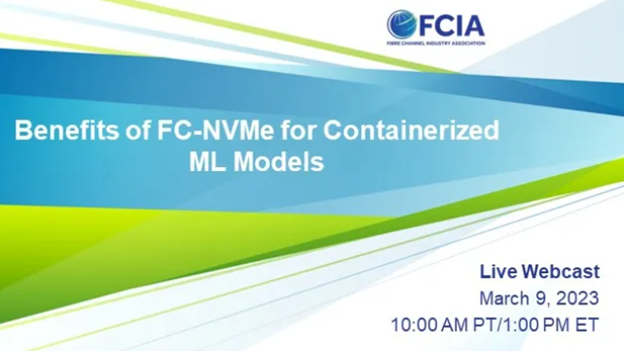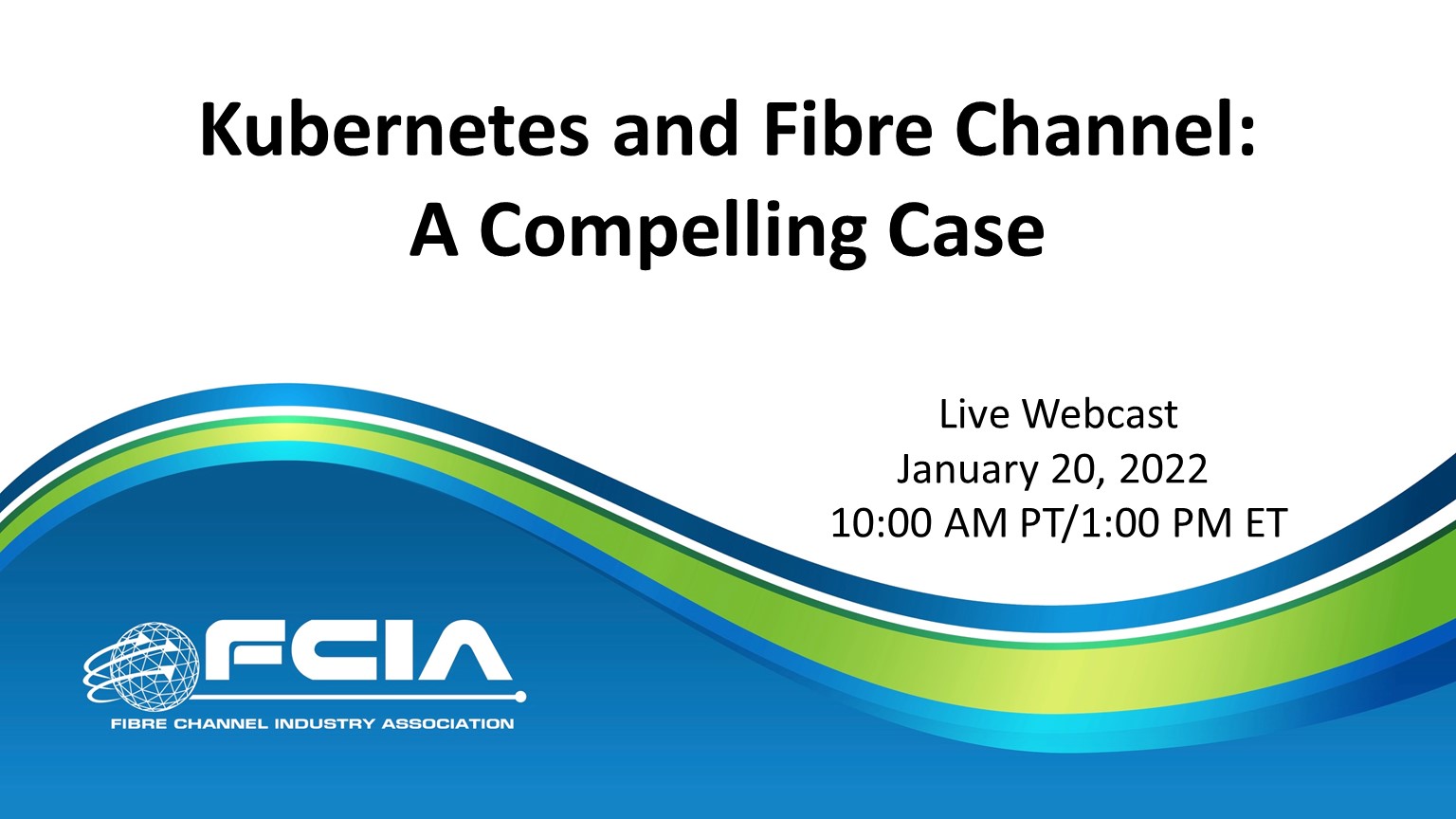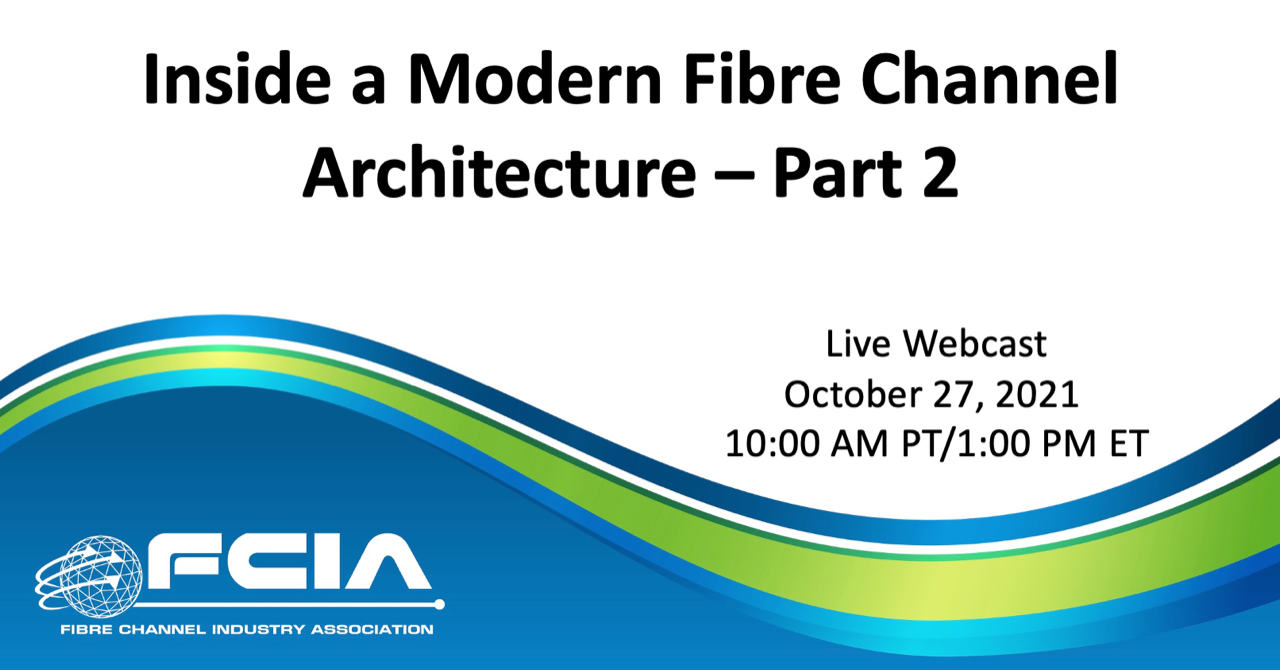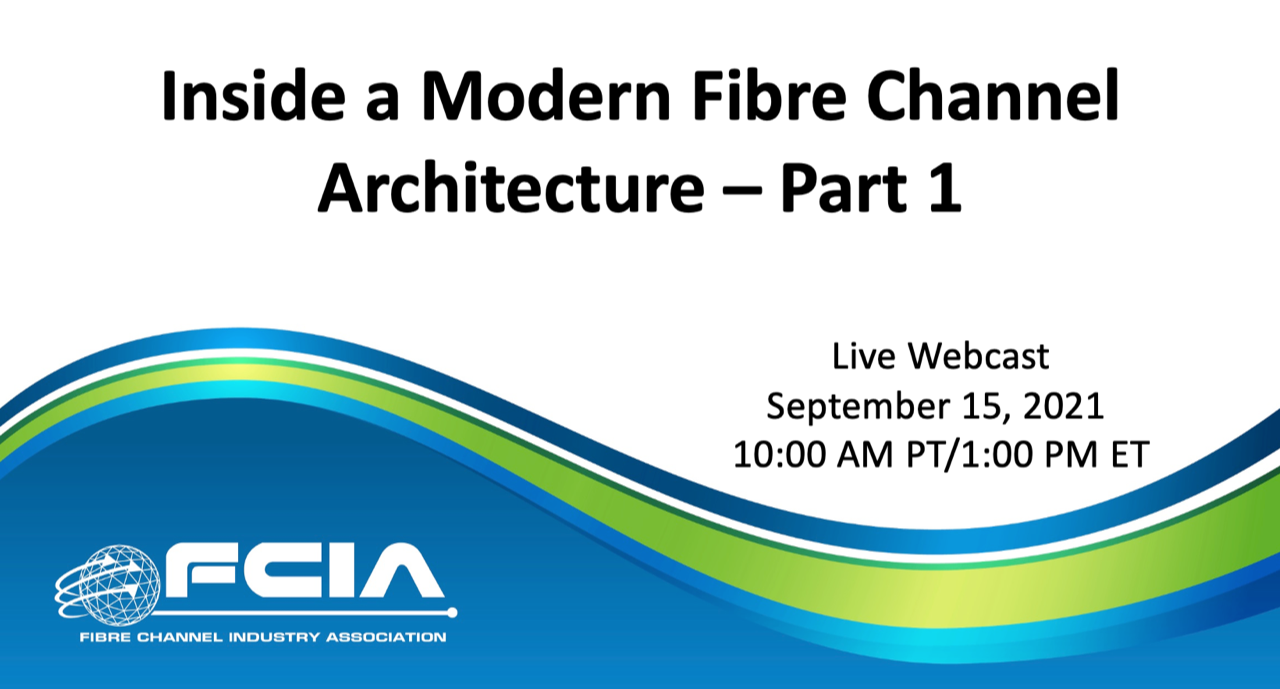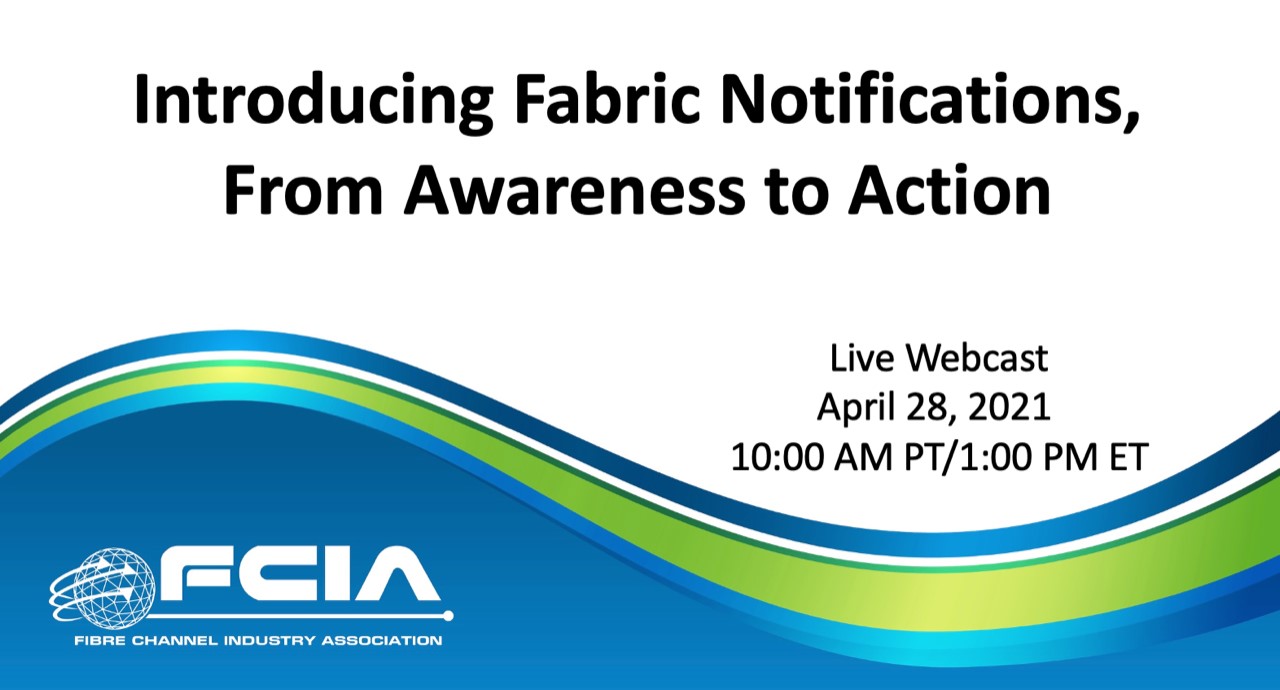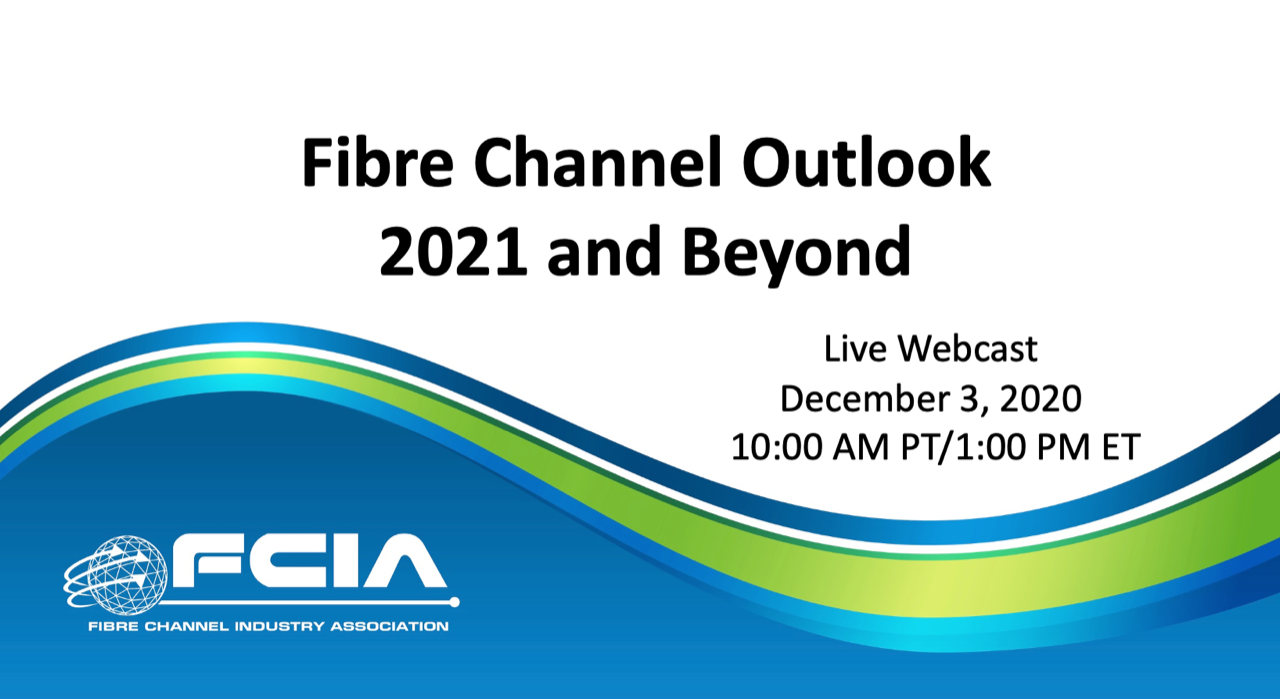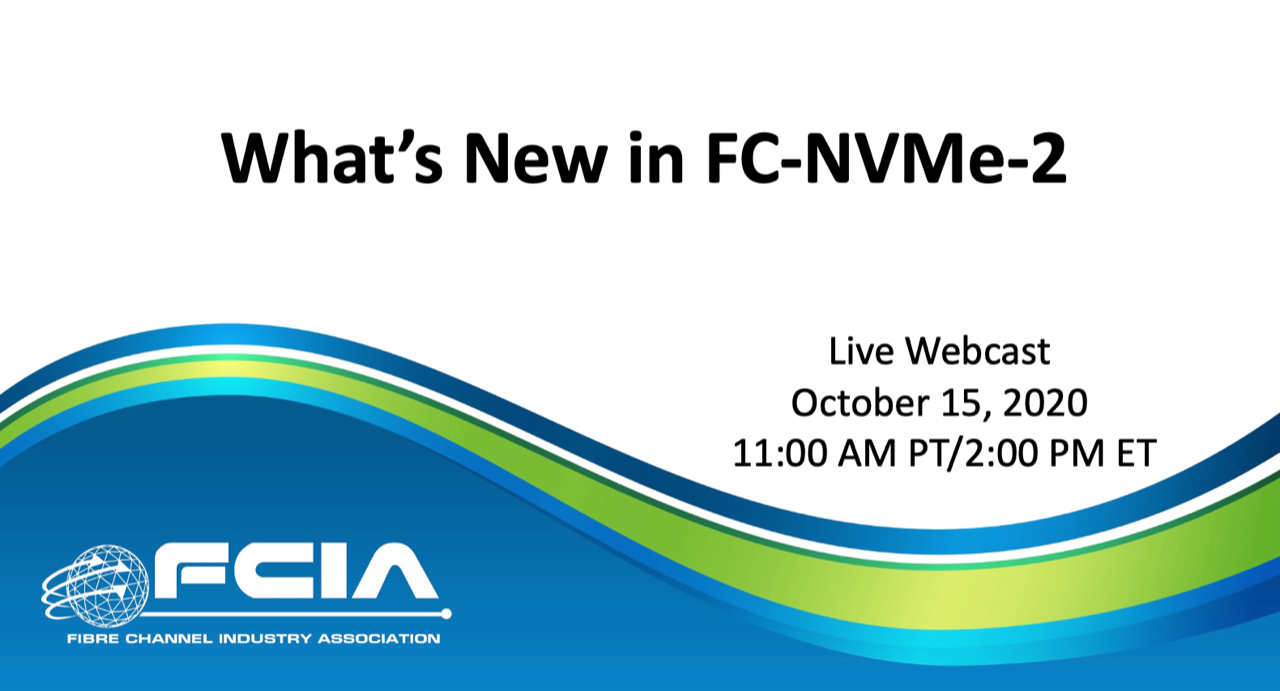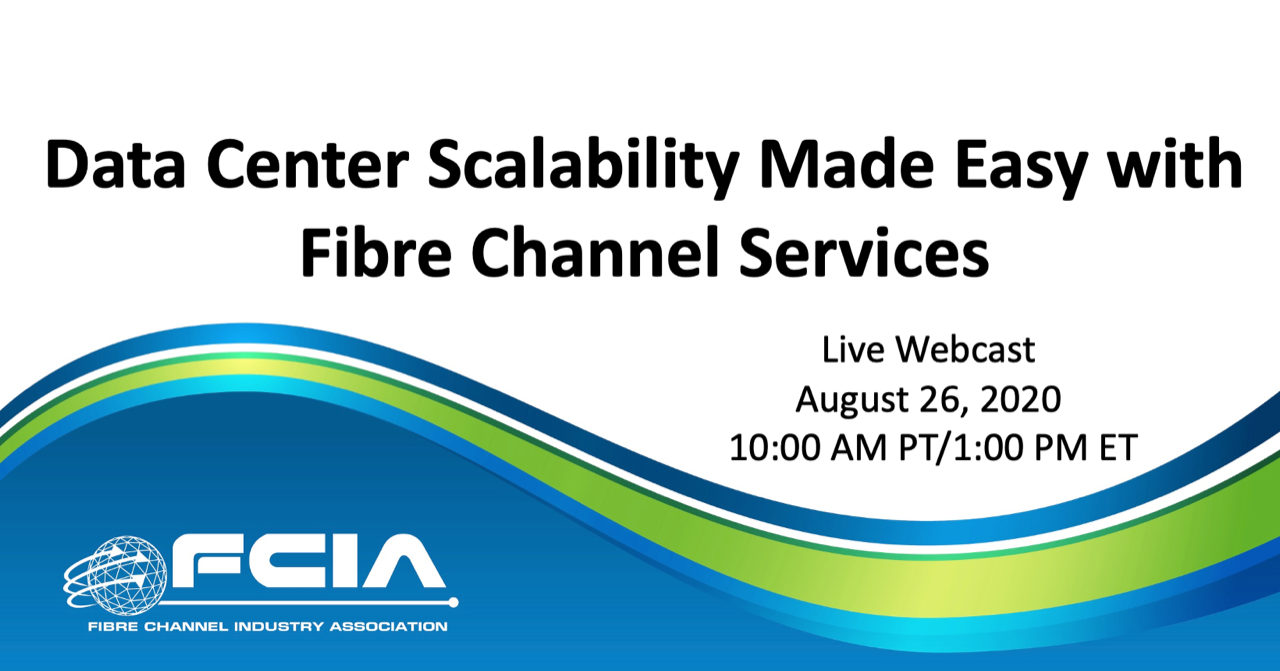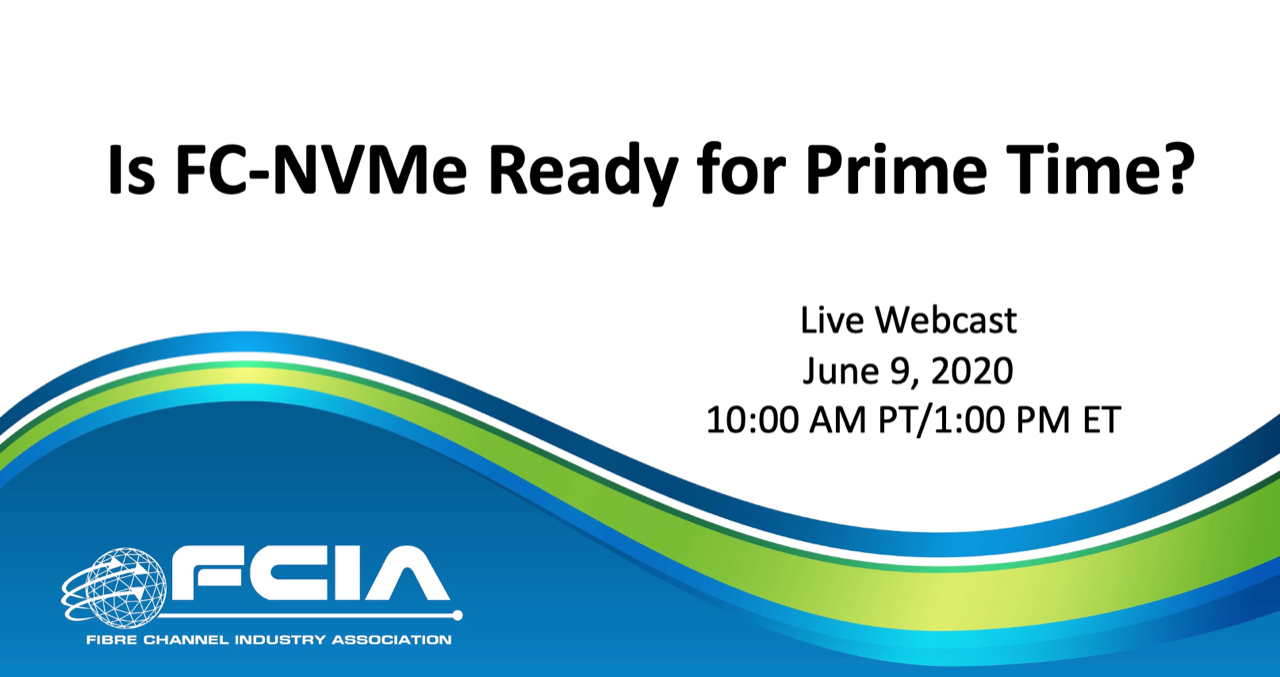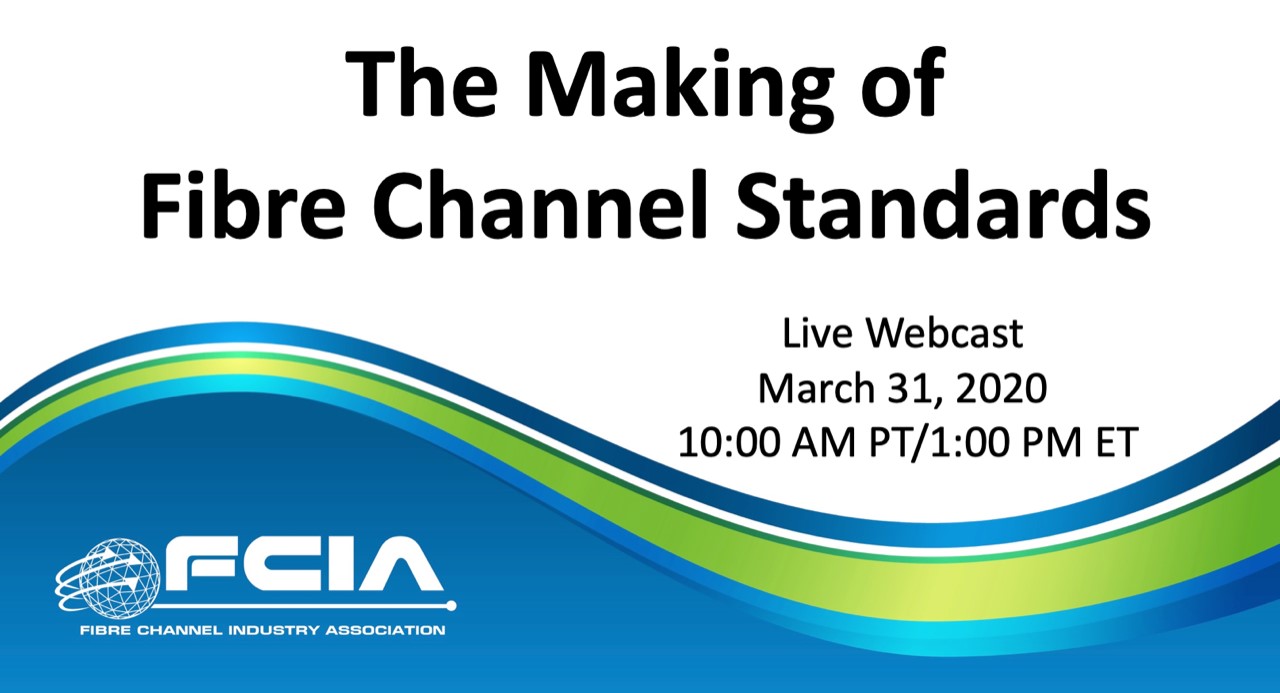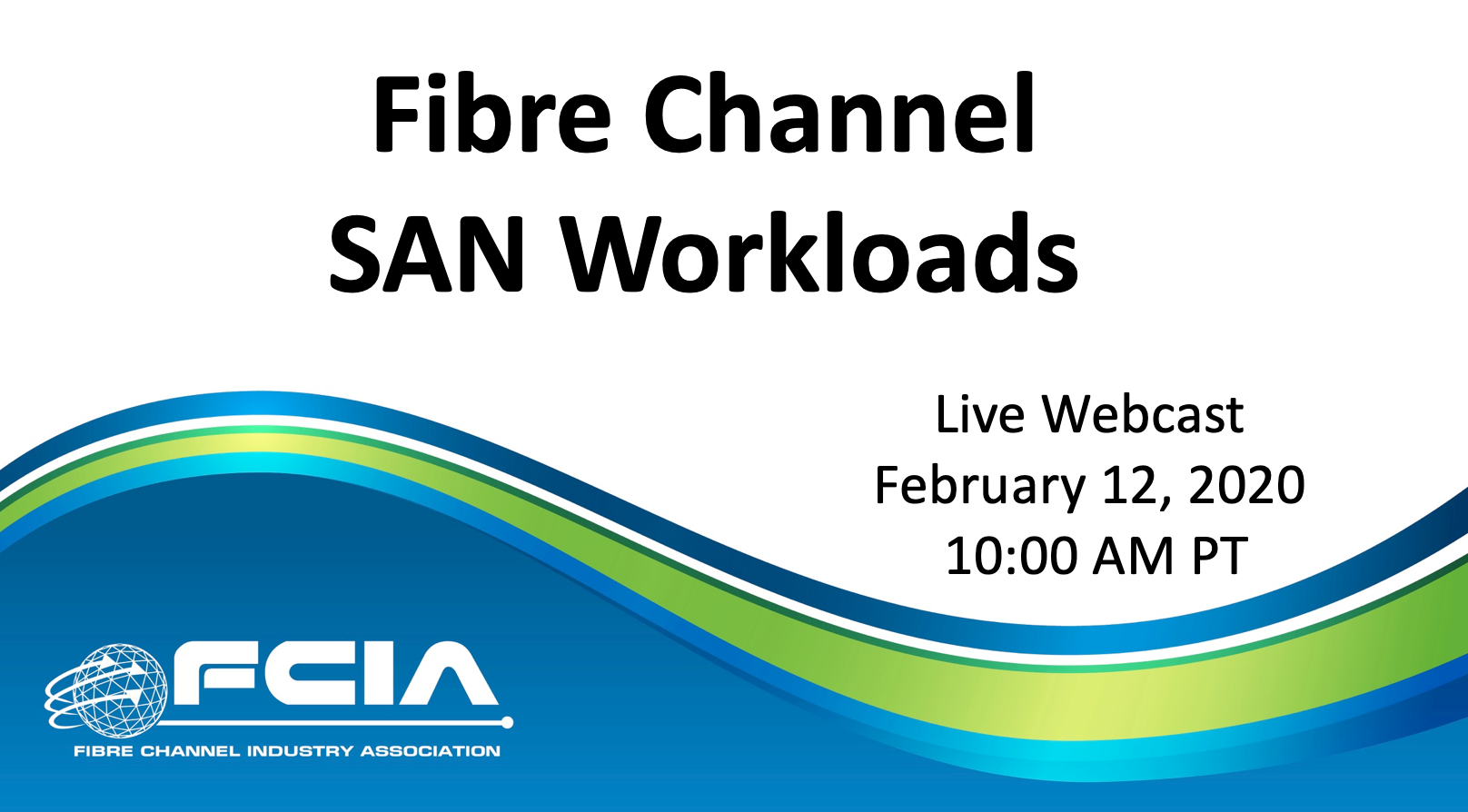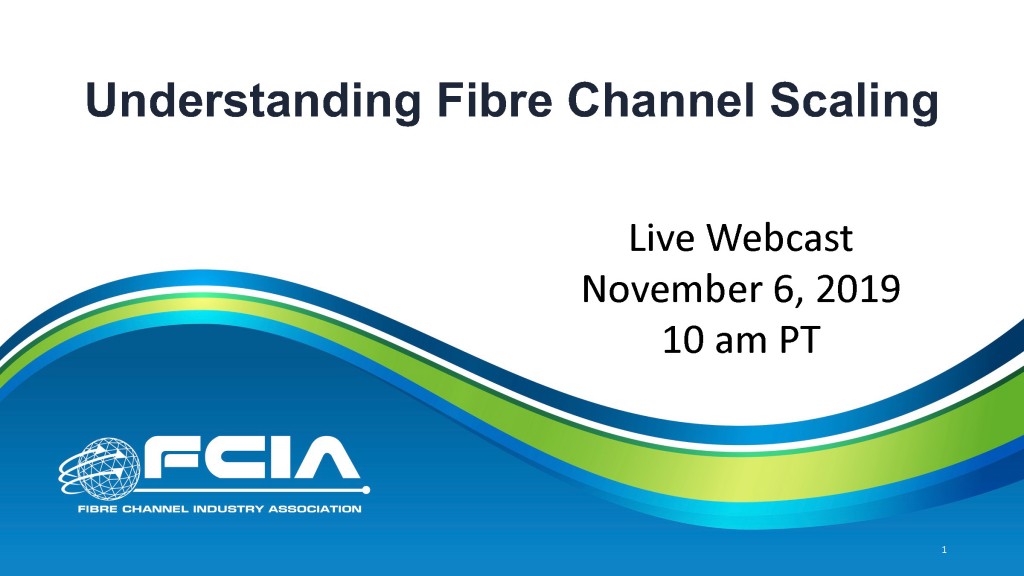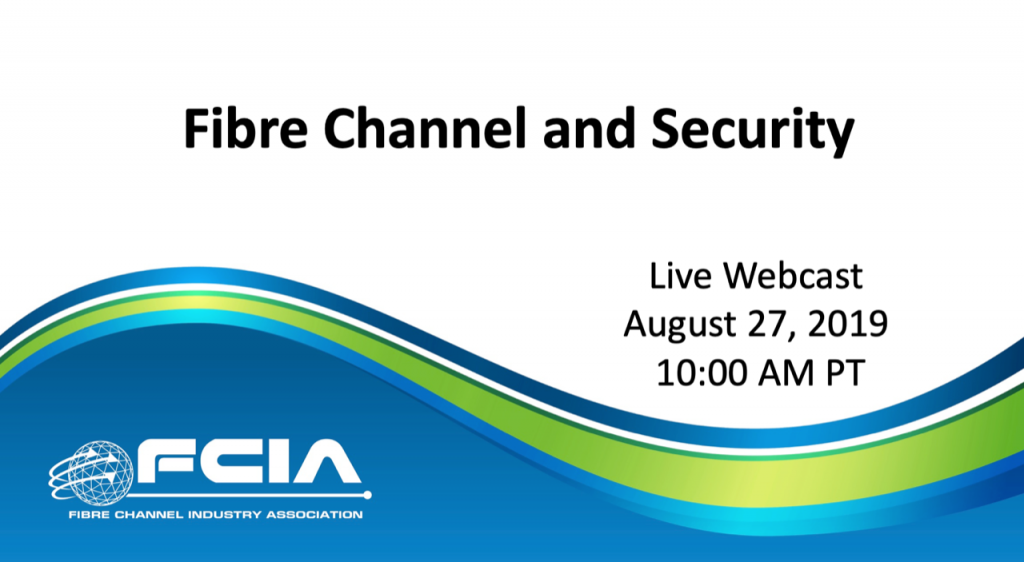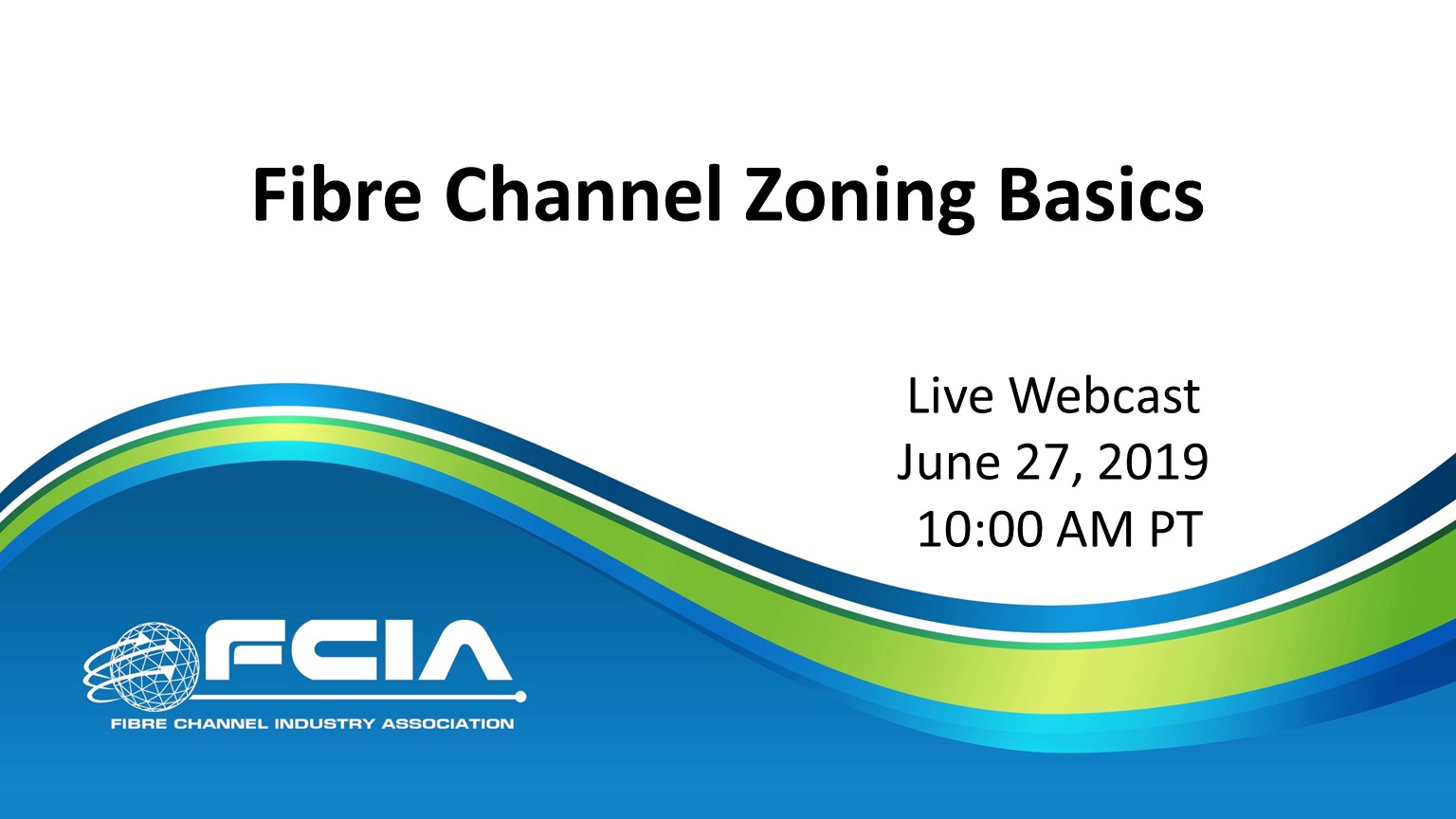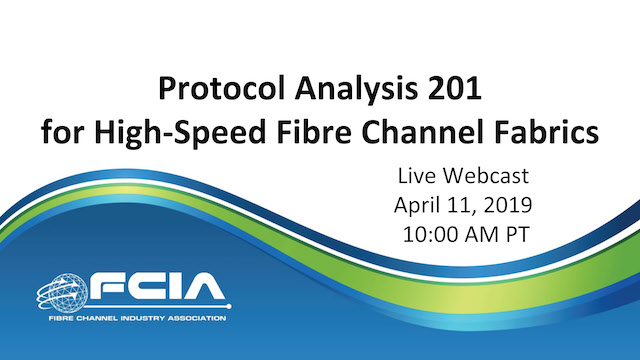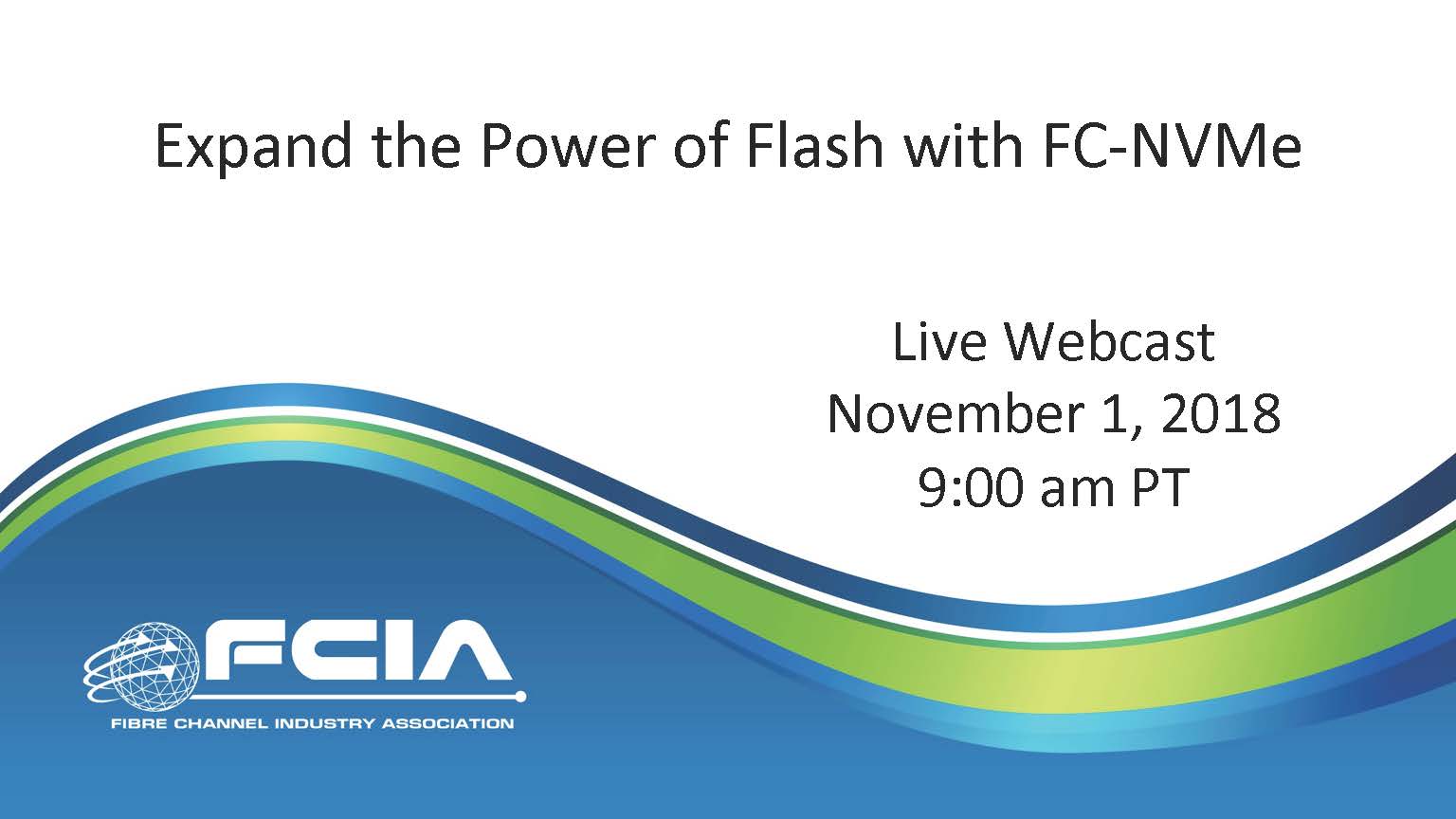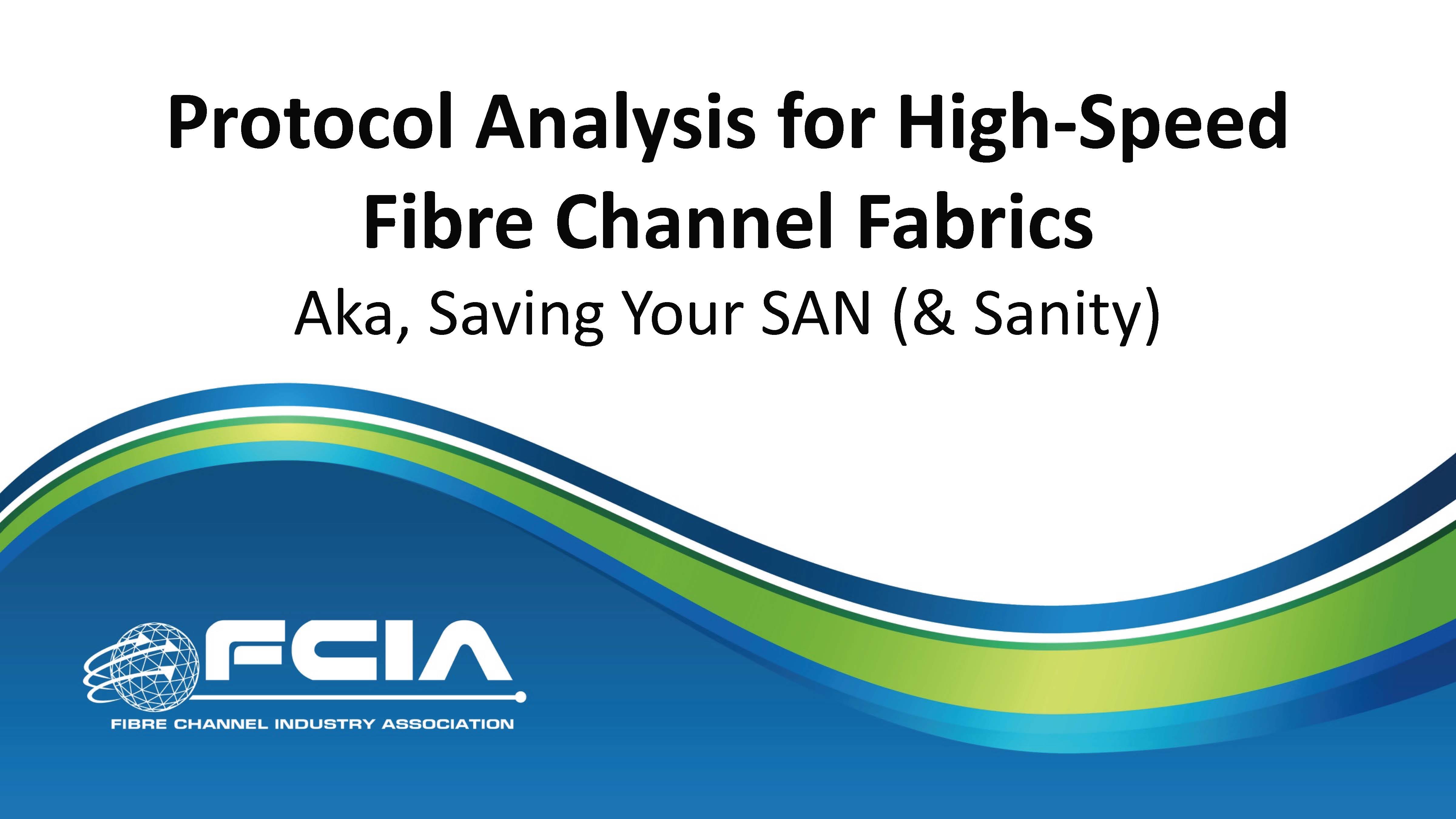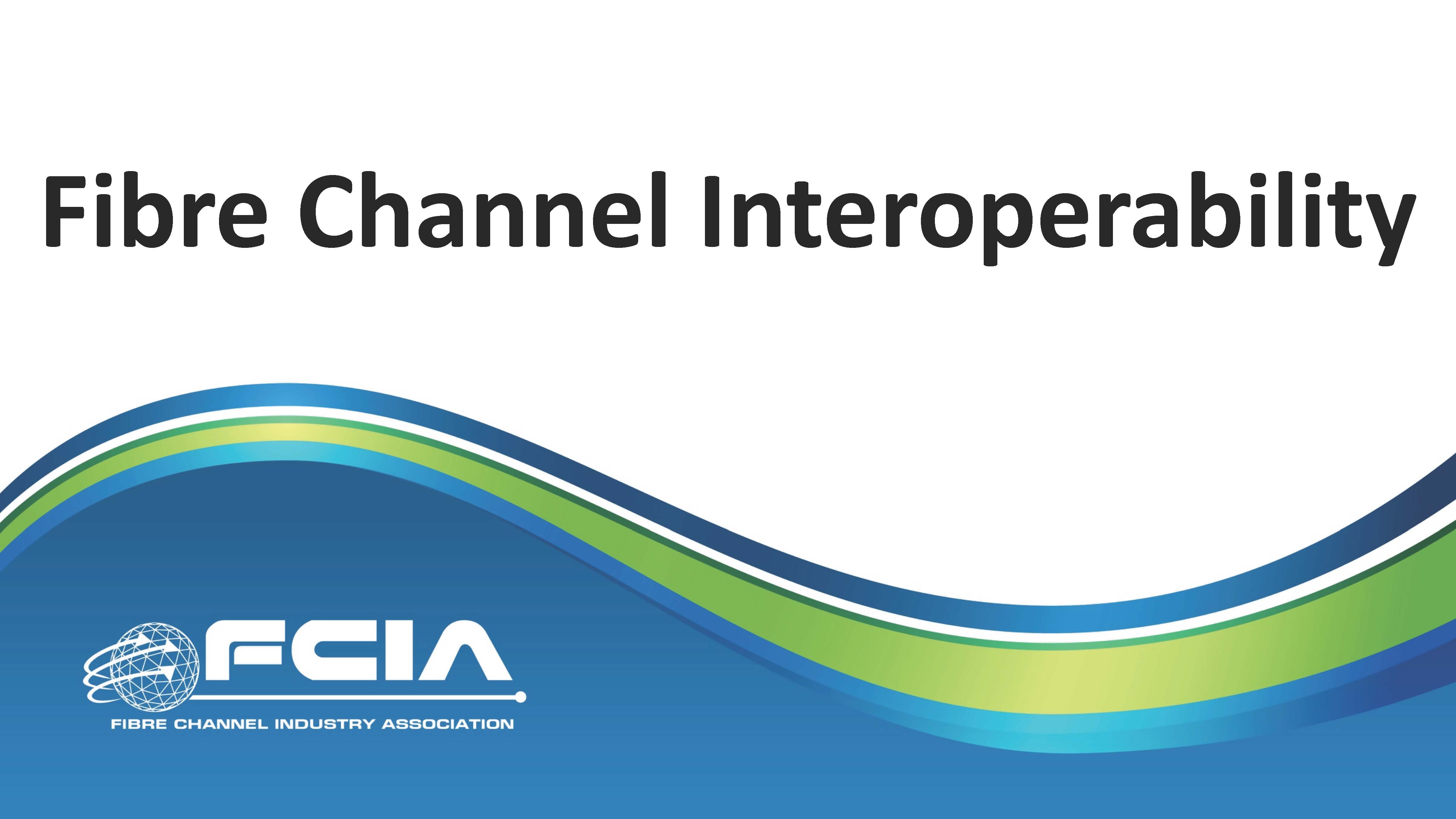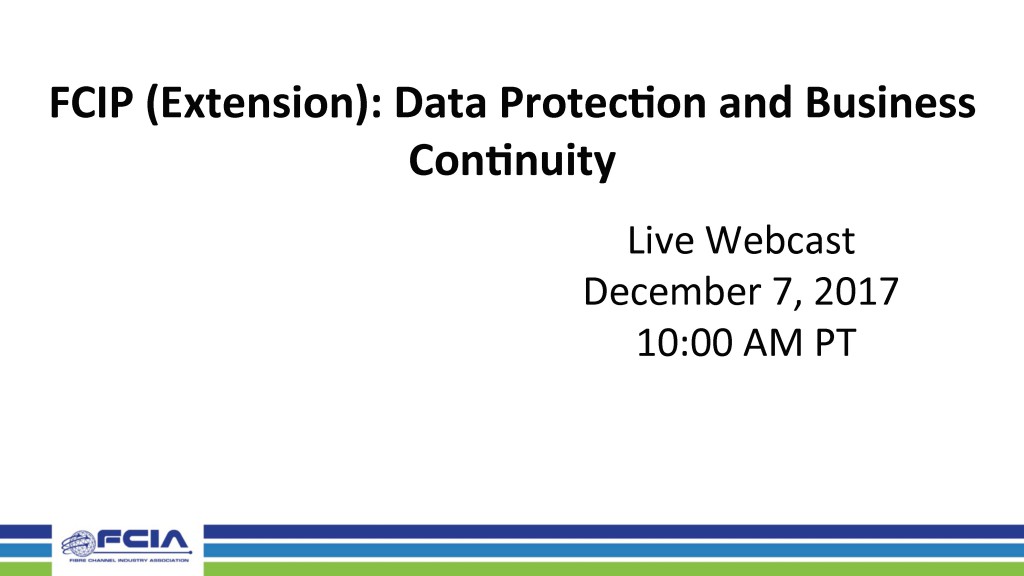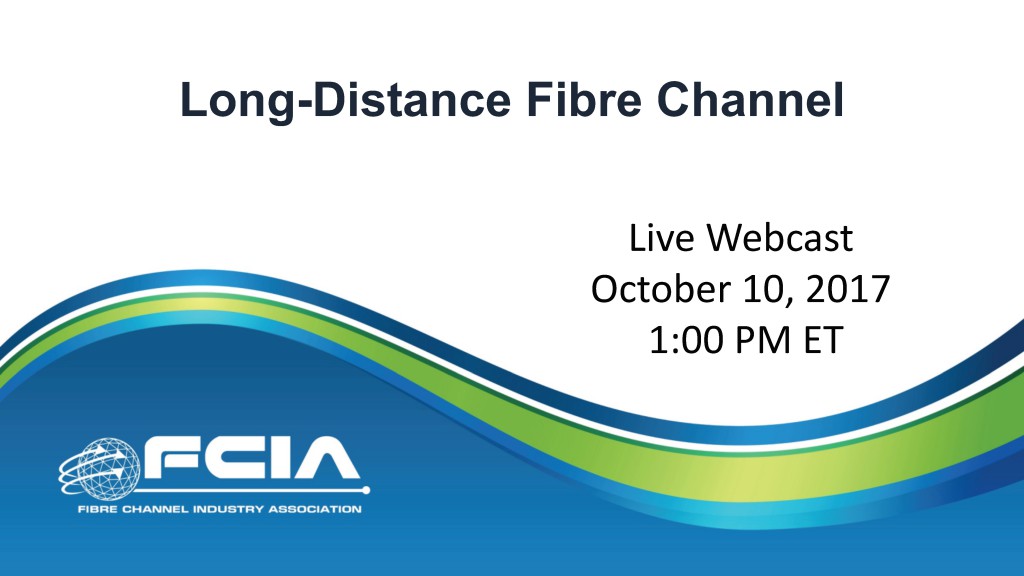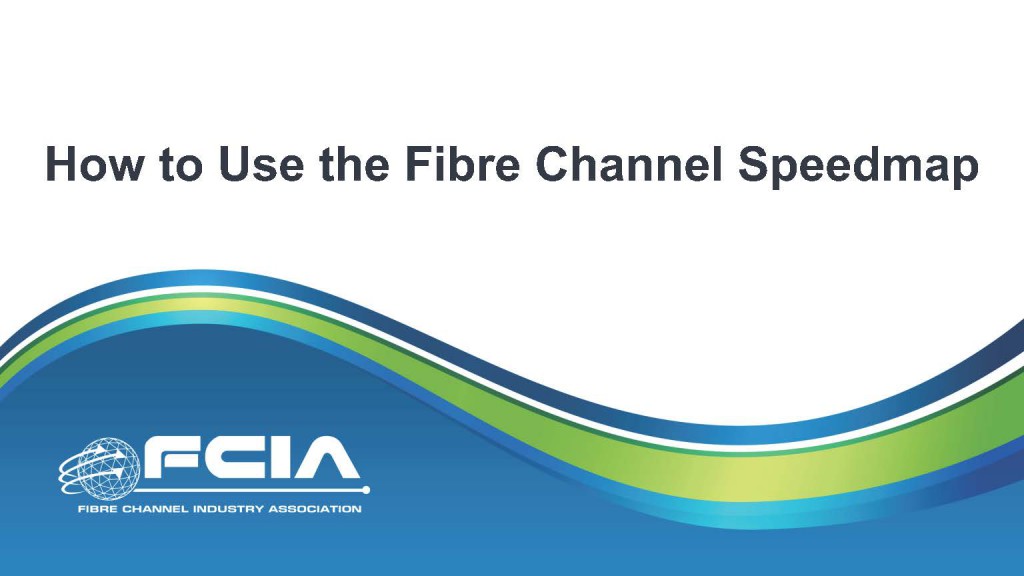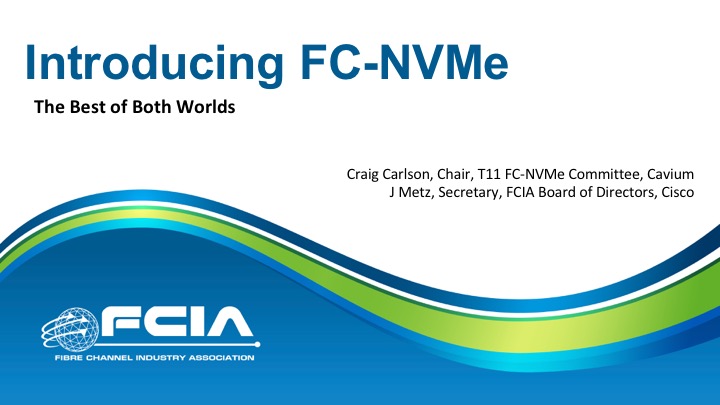Watch on FCIA Youtube Channel
Watch on-Demand on BrightTalk
Click here to view the presentation slides.
Click here to read the Q&A blog related to this webcast.
Organizations often operate data centers in multiple locations and are often geographically distributed to provide scale and disaster recovery capabilities. As with any fabric topology, scalability, data integrity and security are key requirements. This webinar will discuss how Fibre Channel can be effectively deployed in these applications using optical transport technology. Topics to be covered:
- Optical Transport 101: A brief survey of optical networking (DWDM) technology
- Fibre Channel transport via OTN
- Robustness: Optical transport protection options: Resiliency against fiber outages
- Security: Optical transport OTN encryption: No-overhead layer 1 encryption that can be combined with IPSec or other higher-layer security protocols
Watch on FCIA Youtube Channel
Watch on-demand on BrightTalk
Click here to view the presentation slides.
Click here to read the Q&A blog related to this webcast
The majority of today’s SAN infrastructure leverage the traditional SCSI/FCP protocol. The relatively new NVMe/FC protocol has become ubiquitous in enterprise storage offerings, delivering multiple advantages including high performance, low tail latency, and precision error recovery that can run on the same FC SAN infrastructure. In this talk we will discuss:
- The architecture of NVMe/FC at protocol level
- Building blocks of NVMe like NVMe subsystem
- NVMe controllers, Namespaces etc.
- Overview of FC-NVMe T11 standards
- Key advantages of NVMe/FC, including application use cases
Click here to watch on-demand
Click here to watch on the FCIA Youtube channel.
Click here to view the presentation deck.
In this webcast we will discuss 128GFC, the new Fibre Channel speed recently ratified by the T11 Fibre Channel standards committee. This new speed takes Fibre Channel further into the future. The latest generation of Fibre Channel (128GFC) has a rate of 112.2Gbps (PAM4) for a single lane variant. This speed is 5.6% faster than 100Gb Ethernet single lane variants. Fibre Channel was able to increase the speed and still maintain two generations of backward compatibility which is key to Fibre Channel success. Previous generation SFP optical modules (32GFC and 64GFC) will be able to plug into the latest generation of Fibre Channel 128GFC products and 128GFC products will be able to seamlessly interoperate with previous generations of Fibre Channel products.
128GFC products will support existing infrastructure of fiber cables for multi-mode variants and single mode variants. 128GFC is also able to support the previous reach of 100 meters of OM4 without sacrificing performance in link quality or increasing errors (BER).
The Fibre Channel committee also streamlined the process for link speed negotiation and training which are key to multiple generations of backward compatibility. In the webcast we will discuss this significant Fibre Channel advancement.
Click here to watch on FCIA’s Youtube Channel
Click here to watch on BrightTalk
Click here to view the presentation slides.
Click here to read the Q&A blog related to this webcast.
Machine learning (ML) is the study and development of algorithms that improves with use of data. As it deals with the training data, the machine algorithm changes and grows. Most ML models begin with “training data” which the machine processes and begins to “understand” statistically.
Machine learning models are resource intensive. To anticipate, validate, and recalibrate millions of times, they demand a significant amount of processing power. Training an ML model might slow down your machine and hog local resources.
The proposed solution is to containerize ML with NVMe over Fibre Channel (FC-NVMe) by putting your ML models in a container. In this webcast, we will highlight the benefits of containerizing ML models with FC-NVMe, discussing:
- Containers are lightweight software packages that run-in isolation on the host computing environment. Containers are predictable, repetitive, and immutable. This ensures that no unexpected issues occur while moving them to a new system or between environments. A cluster of containers can be created with a configuration suited for machine learning requirements. Containers are also easy to coordinate (or “orchestrate”).
- Artificial Intelligence (AI) at scale sets the standard for storage infrastructure in terms of capacity and performance, making it one of the most crucial factors for containers.
- FC-NVMe is an extension of the NVMe network protocol to Fibre Channel delivering faster and more efficient connectivity between storage and servers and providing the highest throughput and fastest response times.
- The combination of FC-NVMe with an NVMe SSD solution with containerized ML allows orchestration to scale data-intensive workloads and increase data mining speed.
Click here to register!
Click here to view the presentation slides.
Innovation and growth in Fibre Channel adoption continues to grow – and your career can too. Yet there is a lack of training at the academic level in teaching the basics of Fibre Channel as many universities consider the technology mature. The need for beginner-level courses as well as more advanced education for professionals wanting to achieve a deeper level of technical understanding in the subject has led to a number of companies active in the Fibre Channel industry to step up and fill the void.
In fact, between the many vendors in this space and the FCIA itself, there is a plethora of resources. These include classes, webcasts, videos and white papers that cover topics ranging from Fibre Channel basics to fabric notifications, zoning fundamentals, standards development and instructions on how to become a Fibre Channel-based SAN administrator.
How to take advantage of all these educational Fibre Channel resources will be the topic of our this live FCIA webcast on April 13, 2022.
Click here to view on-demand!
Click here to view the presentation slides
Over the past decade IT organizations have discovered the benefits of moving applications and storage to the cloud. Recent trends point to an increase of on premises hybrid cloud solutions. Cloud-native applications running in containers has driven the need for high-performance persistent storage that is both easy to deploy and manage.
In this live webcast, FCIA experts will explore the role that Fibre Channel plays in merging the benefits of a cloud-based infrastructure with the advantages of an on-premises hosting solution for gains in reliability, performance, and scalability – all with cost reduction. With a focus on Kubernetes, we will explain how these best practice environments can be combined for the next generation of application deployments. Join us for a discussion on:
- Cloud market trends
- How organizations are deploying cloud
- Introduction to containers and persistent storage
- The role of Fibre Channel in Kubernetes
- Evolution of container storage interfaces and CSI
- Fibre Channel fabric requirements and considerations
Click here to view the on-demand webinar!
Click here to view the presentation slides
Fibre Channel is the original secure storage fabric. Perfected over 25 years, the zoning service in Fibre Channel makes security possible by ensuring that end devices are able to communicate only with the set of devices explicitly permitted. As a follow up to our presentation on Fibre Channel Basics, this live webcast is a more advanced session that will focus on Zoning for the real world, covering:
- What is Zoning
- Why you’d want to Zone
- How Zoning works
- Different types of zones
- Activation flow
- Zoning configuration
- Zoning and security
- On-going management and monitoring
- Real-world examples: How to zone for database applications, virtualization and more
Click here to watch on demand.
Click here to download presentation slides.
Click here to watch on the FCIA YouTube channel.
We continue our discussion on how Fibre Channel is purpose built and engineered to meet the demands of enterprise data centers requiring rock solid reliability, high performance, and scalability. In other words, Fibre Channel technology is storage technology!
At Part 2 of “Inside a Modern Fibre Channel Architecture” our FCIA experts return to dive into:
- Building blocks and their hierarchy
- Frames, Sequences, Exchanges, Protocols
- Segmentation and reassembly
- Error detection and recovery
- Current enhancements e.g., Congestion Notifications
Click here to view the presentation on-demand.
Click here to view the presentation slides.
Click here to watch on the FCIA YouTube channel.
Fibre Channel (FC) is the storage networking protocol for enterprise data centers with over 142 million ports having been shipped. Fibre Channel is purpose built and engineered to meet the demands for enterprise data centers that require rock solid reliability, high performance, and scalability. In other words, Fibre Channel technology transports FC-SB-x, FCP, and FC-NVMe storage protocols natively.
This webcast explains how Fibre Channel is architected for unparalleled performance for storage protocols. If you are interested in this architecture, please join us to learn more on the Fibre Channel:
- Functional levels and components
- Physical model
- Communication models
- Interconnect topologies
- Classes of service
- General Fabric model
- Generic Services
This all leads to a future webcast where we’ll dive into:
- Building blocks and their hierarchy
- Frames, Sequences, Exchanges, Protocols
- Segmentation and reassembly
- Error detection and recovery
- Current enhancements e.g., Congestion Notifications
Click here to view on-demand.
Click here to view the presentation slides.
Click here to watch on the FCIA Youtube Channel
Click here for the post-event Q&A Blog
Fibre Channel (FC) networks run on a highly streamlined protocol designed to offer persistently high performance. The FC protocol has built-in feedback mechanisms to avoid congestion and to alleviate it if it occurs. There are many new technologies being developed to monitor and manage performance and availability issues that may arise from time to time. Moreover, many of these tools are available across the ecosystem and are part of the FC standard.
Come listen to Fibre Channel technology experts to understand:
• New technologies like FPIN notification
• Automation built-in the storage networks
• Exciting new innovations coming to the FC network
• How to ensure predictable performance
• QoS considerations
• Why FC is the best transport protocol for storage environments
Click here to watch the on-demand presentation.
Click here to download the presentation slides
Click here to watch on the FCIA YouTube channel.
Got Fibre Channel questions? Here’s your chance to get them answered. Coming together from multiple vendors and various technical disciplines, the Fibre Channel Industry Association (FCIA’s) depth of Fibre Channel expertise in unmatched. This panel is moderated by Scott Sinclair, Senior Analyst at the Enterprise Strategy Group.
Click here to view on-demand.
Click here to view the presentation slides.
Click here to view the Q&A blog.
Gen 7, the newest generation of Fibre Channel, doubles performance to 64GFC with switches and HBAs now available in the market. But what does 2021 hold for the network protocol standard? What impact will NVMe over Fibre Channel have in the datacenter? Tune into this webcast to hear answers to these questions and more.
Founder and principal market analyst Casey Quillin of Quillin Research, will provide his perspective on storage networking trends and will join FCIA experts as they share insights on the continued innovation of Fibre Channel and what datacenter managers can expect in 2021 and beyond.
Attendees will be provided with a link to the latest edition of the 2020 Fibre Channel Solutions Guide, packed with additional technical information to help you navigate the networking landscape.
Join us for a look at:
- Storage networking trends
- The features and timing of Fibre Channel technology migration reflected in the Fibre Channel Roadmap
- The need for standards
- Fibre Channel security standards
Click here to view the on-demand presentation.
Click here to view the presentation slides.
Click here to view the Q&A blog.
Why do we need enhanced error recovery? And, how does it work? In this webcast we explore the fact that “bit errors happen” and how that occurs. We also do a deep dive into the mechanism of the enhanced error recovery added to FC-NVMe-2. Join FCIA experts as they guide you through the intricacies of the error recovery that allows FC-NVMe-2 to build on the already reliable Fibre Channel to provide the most reliable NVMe over Fabrics deployment possible.
Click here to view the on-demand presentation.
Click here to view the presentation slides
Fibre Channel Services such as the Fabric Login Server, Fabric Controller, and Name Server are used to support management and operation of a Fibre Channel Fabric by providing a method of registering and maintaining devices connected in the network. As the need for additional Fabric Services, such as traffic flow analysis and congestion management have surfaced, Fibre Channel continues to evolve to ensure easy data center scalability.
In this webcast, FCIA experts will provide context to the terminology and dive into Fibre Channel Services, including device and topology discovery, zoning, security, clock synchronization and management. It will also decode some common acronyms like, FC-CT, FC-GS-9, and FC-SW-8.
Join us to learn:
- What are Fabric Services?
- Overview of long-standing Fabric Services and what the newer Fabric Services provide
- What is FC-CT? And how does it relate to Fibre Channel Fabric Services?
- Fibre Channel Generic Services and Switch Fabric functionality
Click here to view the on-demand presentation.
Click here to view the presentation slides
Click here to view the post-event Q&A
The T11 specification for NVMe over Fibre Channel (FC-NVMe) was completed in 2018, since that time, the FCIA has held numerous plugfest events and products have been shipping for a few years. So where are we today with NVMe over Fibre Channel solutions?
This webcast will take an early 2020 point-in-time snapshot of where the industry is, discuss products available today, and address common questions around:
- Which host environments can use FC-NVMe
- What is required from the fabric
- Breadth of supporting storage solutions
- Application benefits we have seen so far
- FC-NVMe strengths and differentiators
And most importantly, is FC-NVMe ready for prime time?
Click here to register.
Click here to view the presentation
We rely on technical standards for all facets of daily life. Yet it is easy to take technology standards for granted, forgetting that they underpin the technology used every day. As participants in the IT sector it is important for us to learn how standards are developed, why standards matter and how we all benefit from them.
In this webcast, we’ll pull back the curtain on the standard development process, explain what makes something a standard, and decode a few funky common acronyms. You’ll learn:
- The differences between a standard and a specification
- Who is INCITS and what’s their role?
- T11 Fibre Channel standards development process
- T11 Fibre Channel Standards
- Current Fibre Channel standards under development
- Benefits of standards when architecting Fibre Channel solutions
Click here to view on demand
Click here to view the presentation.
Click here to view the post-event Q&A Blog
Fibre Channel (FC) SAN workloads are not difficult, but there are several people who do not understand how the workloads line up to appropriate storage protocol and their characteristics. Different workloads have different “Fingerprints,” so to speak. Since FC SANs are block, they work very well with applications that have a lot of transactional data, a lot of random read/write loads, and are particularly good for virtual machine file systems.
This webinar will discuss:
- I/O fingerprints: I/O block sizes & IOPS requirements for various “FC SAN applications”
- An overview of application access patterns, guided by best practices and experience
- How FC fulfills these IOPS requirements and how CPU BW is as important as IOPS
We will briefly investigate application sensitivity to latency, and show how protocol can affect performance.
Click here to view on demand
Click here to view the presentation.
One of Fibre Channel’s greatest strengths is its ability to scale to thousands and thousands of nodes, while providing predictable performance. So, when we say that Fibre Channel has unmatched scalability, what does that actually mean? And how does it work?
We often hear about “designed from the ground up,” but in this case it’s actually true. From each individual link, to the overall domain architecture, each step along the way is intended to be approached in a scalable fashion.
In this webinar, we’ll be breaking down the pieces of the puzzle that help give Fibre Channel its robustness when you’re working at fabrics even greater than 10,000 nodes. We’ll be talking about:
•What a deterministic storage network is
•Fabric management principles
•Negotiated credit transfers (buffer-to-buffer credits)
•Network Engineering/Design Principles
•Oversubscription and Fan-In Ratios
•Topologies that help scale
•Domains and Fabric limits
•Consistency of performance at scale
Along the way, we’ll be talking about some of the ways that Fibre Channel differs from other popular storage networks as they approach large-scale environments, and how it handles issues that arise in such cases.
Please join us on November 6th at 10:00 am PT/1:00 pm ET for another educational webinar on Fibre Channel!
Click here to download a PDF of the webcast slides
Click here to view the webinar
Fibre Channel has long been known to be a very secure protocol for storage. The sheer variety of environments in which Fibre Channel fabrics are deployed makes it very difficult to simply rely only on physical security.
This webcast takes a deep into the guts of security aspects of Fibre Channel, looking closely at the protocols used to implement security in a Fibre Channel fabric, covering:
- The definitions of the protocols to authenticate Fibre Channel devices
- What are the different classes of threats, and what are the mechanisms to protect against them
- What are session keys and how to set them up
- How Fibre Channel negotiates these parameters to insure frame-by-frame integrity and confidentiality
- How Fibre Channel establishes and distributes policies across a fabric
Click here to download a PDF of the webcast slides
Click here to view the webinar
Click here to view the Q&A Blog
In this back-to-basics Fibre Channel webinar, we talk about one of the most fundamental functions of the protocol and what makes it so reliable, predictable and secure: Zoning. The ability to separate and isolate traffic into its own channel, undisturbed by other traffic, is part of what makes Fibre Channel so powerful. The ability to secure those connections in zones adds built-in security to the connections.
In this webinar, you’ll find out:
- What is Zoning
- Why you’d want to Zone
- The Different Types of Zoning
- Consequences of Zoning
- Zoning best practices for different types of applications
Click here to download a PDF of the webcast slides
Click here to view the webinar
Q&A Blog – Coming soon
In the FCIA webcast Protocol Analysis for High-Speed Fibre Channel Fabrics, experts covered the basics on protocol analysis tools and how to incorporate them into the “best practices” application of SAN problem solving. In this 201 lesson our experts return to provide a deeper dive into how to interpret the output and results from the protocol analyzers, discussing:
- Post-capture analysis – Graphing, Trace reading, Performance metrics
- Benefits of purposeful error injection
- Insight into using signal jammers
- More Layer 2-3 and translation layers debug
- Link Services and Extended Link Services – LRR Link Ready Rest
Click here to download a PDF of the webcast slides
Click here to view the webinar
Click here to view the Q&A Blog
FICON (Fibre Channel Connection) is an upper-level protocol supported by mainframe servers and attached enterprise-class storage controllers that utilize Fibre Channel as the underlying transport. The FCIA FICON 101 webcast described some of the key characteristics of the mainframe and how FICON satisfies the demands placed on mainframes for reliable and efficient access to data. FCIA experts gave a brief introduction into the layers of architecture (system/device and link) that the FICON protocol bridges.
Using the FICON 101 session as a springboard, our experts dive deeper into the architectural flow of FICON and how it leverages Fibre Channel to be an optimal mainframe transport, discussing:
- Brief review of FICON 101 concepts
- How FICON (FC-SB-x) maps onto the Fibre Channel FC-2 layer
- The evolution of the FICON protocol optimizations
- How FICON adapts to new technologies
Click here to download a PDF of the webcast slides
Click here to view the webinar
Click here for the Q&A Blog
Fibre Channel’s speed roadmap defines a well-understood technological trend: the need to double the bit rate in the channel without doubling the required bandwidth.
In order to do this, PAM4 (pulse-amplitude modulation, with four levels of pulse modulation), enters the Fibre Channel physical layer picture. With the use of four signal levels instead of two, and with each signal level corresponding to a two-bit symbol, the standards define 64GFC operation while maintaining backward compatibility with 32GFC and 16GFC.
This advanced technical session will cover the T11 standards which define 64GFC serial Fibre Channel, backwards speed auto-negotiation compatibility, and compatible form factors:
•New physical layer and specification challenges for PAM4, which includes eye openings, crosstalk sensitivity, and new test methodologies and parameters
•Transceivers, their form factors, and how 64GFC maintains backward compatibility with multi-mode fibre cable deployments in the data center, including distance specifications
•Discussion of protocol changes, and an overview of backward-compatible link speed and forward error correction (FEC) negotiation
•The FCIA’s Fibre Channel speed roadmap and evolution, and new technologies under consideration
Click here to download a PDF of the webcast slides
Click here to view the webinar
Q&A Blog here!
Flash is really fast, and performance-hungry applications must be able to access it wherever it is located. Luckily, NVMe can take advantage of flash throughout a computer system.
However, accessing flash over a network can introduce problems which designers must solve. Accesses can take much longer than local flash, latency can rise significantly, networking issues can raise their ugly heads, and performance can vary greatly depending on network load and competition for resources.
Ways to solve such problems include sequence-level error recovery, prioritization for virtualized environments, and improved forward error correction. And – surprise! – all these are already part of the Fibre Channel standard or the emerging FC-NVMe transport protocol.
Click here to download a PDF of the webcast slides
Click here to view the webinar
Click here for the Q&A Blog
The growth and centralization of mission critical datacenter SAN environments has exposed the fact that many small yet seemingly insignificant problems have the potential of becoming large scale and impactful events, unless properly contained or controlled. Root cause analysis requirements now encompass all layers of the fabric architecture, and new storage protocols that usurp the traditional network stack (i.e. FCoE, iWARP, NVMe over Fabrics, etc.) for purposes of expedited data delivery place additional analytical demands on the datacenter manager. To be sure, all tools have limitations in their effectiveness and areas of coverage, so a well-constructed “collage” of best practices and effective and efficient analysis tools must be developed. To that end, recognizing and reducing the effect of those limitations is essential.
This webcast introduces Protocol Analysis tools and how they may be incorporated into the “best practices” application of SAN problem solving. We will review:
- The protocol of the Phy
- Use of “in-line” capture tools
- Benefits of purposeful error injection for developing and supporting today’s high-speed Fibre Channel storage fabrics
Learn how you can save your SAN (and your sanity!)
Click here to download a PDF of the webcast slides
Click here to view the webinar
Click here for the Q&A Blog
Interoperability is a primary basis for the predictable behavior of a fibre channel (FC) SAN. FC interoperability implies standards conformance by definition. Interoperability also implies exchanges between a range of products, or similar products from one or more different suppliers, or even between past and future revisions of the same products. Interoperability may be developed as a special measure between two products, while excluding the rest, and still be standards conformant. When a supplier is forced to adapt its system to a system that is not based on standards, it is not interoperability but rather, only compatibility.
In this webcast, FCIA experts delve into the many dimensions of FC interoperability, discussing:
- Standards and conformance
- Validation of conformance and interoperability
- FC-NVMe conformance and interoperability
- Interoperability matrices
- Multi-generational interoperability
- Use case examples of interoperability
Click here to download a PDF of the webcast slides
Click here to view the webinar
Click here for the Q&A Blog
FICON (Fibre Channel Connection) is an upper-level protocol supported by mainframe servers and attached enterprise-class storage controllers that utilize Fibre Channel as the underlying transport. Mainframes are built to provide a robust and resilient IT infrastructure, and FICON is a key element of their ability to meet the increasing demands placed on reliable and efficient access to data. What are some of the key objectives and benefits of the FICON protocol? And what are the characteristics that make FICON relevant in today’s datacenters for mission-critical workloads?
In this webcast you’ll learn:
- The world of the mainframe
- The characteristics of mainframe I/O and FICON architecture
- Key features and benefits of FICON
Click here to download a PDF of the webcast slides
Click here to view the webinar
Click here for the Questions & Answers blog
Looking for more cost-effective ways to implement fibre channel cabling? At this webcast you will learn why proper cabling is important and how it fits into data center designs. FCIA experts discuss:
- Cable and connector types, cassettes, patch panels and other cabling products
- Variables in Fiber Optic and Copper Cables: Reflectance, Insertion Loss, Crosstalk, Speed/Length Limitations and more
- Different variations of Structured Cabling in an environment with FC
- Helpful tips when planning and implementing a cabling infrastructure within a SAN
- Data center infrastructure layout examples
Click here to download a PDF of the webcast slides
Click here to view the webinar
Click here to view the Questions & Answers blog
Today’s Fibre Channel SANs are tasked with reliably delivering huge amounts of data with almost zero latency in an environment with a large variance of end device capabilities. Fibre Channel is a lossless network protocol, but what are the ramifications? What is considered a good SAN design and what are best practices? What situations can lead to suboptimal performance? How can a device that is not performing well affect the performance of devices even on different parts of the SAN? Can a device that is returning credits without delay affect the SAN just like a device that is returning credits slowly? This webcast provides the answers to these questions and more. For answers, join the FCIA on February 6th for our live webcast.
Click here to download a PDF of the webcast slides
Click here to view the webinar
Click here to view the Questions & Answers blog
Disaster may strike anywhere and occurs in many shapes and sizes. Transporting data over significant distance beyond the reach of a threatening event preserves data so organizations can rapidly recover in the event of a site going down.
This makes deploying a disaster recovery infrastructure between data centers with fast, continuous, and easy replication of mission-critical data to anywhere in the world essential. Fibre Channel over IP (FCIP), often referred to as “Extension,” is used to connect SANs across distance using IP networks. FCIP is commonly used for Remote Data Replication (RDR) between Enterprise Storage Arrays and Remote Tape applications, for the purpose of Business Continuance via Disaster Recovery (BC/DR). This webcast covers best known methods for deployment with extension architectures, extension in routed topologies, and performance optimization for remote replication.
Click here to download a PDF of the webcast slides
Click here to view the webinar
As people learn more about Fibre Channel and are curious about NVMe over Fibre Channel (FC-NVMe), questions arise around how storage solutions are going to be affected by the new technology. Perhaps the least understood aspect of storage networks involves distance solutions. In this webcast, FCIA experts highlight Fibre Channel long distance use cases and answer the most common questions to help viewers better understand and plan for distance solutions using Fibre Channel.
Click here to download a PDF of the webcast slides
Click here to view the webinar
Click here to view the Questions & Answers blog
As FC-NVMe (NVMe over Fibre Channel) is preparing for it’s official launch, there have been numerous questions about how the technology works, how it gets implemented, and what makes it special when compared to traditional, SCSI-based Fibre Channel. This webcast is an advanced, deep dive of the bits and bytes of FC-NVMe.
Click here to download a PDF of the webcast slides
Click here to view the webinar
Click here to view the Questions & Answers blog
Fibre Channel (FC) is the storage networking protocol for enterprise data centers with over 11 million ports deployed. Fibre Channel is purpose-built–and engineered to meet the demands for enterprise data centers that require rock solid reliability, high performance and scalability. It can even transport new storage protocols like NVMe natively. This webcast explains how FC provides unparalleled performance for storage systems.
Click here to download a PDF of the webcast slides
Click here to view the webinar
Fibre Channel is the most well known dedicated storage networking protocol in use in data centers today, and is considered the gold standard for storage in terms of availability, reliability, and scalability. However, it does require some specific design and planning requirements. For that, storage administrators use the Fibre Channel Speedmap. Watch this on-demand webcast to learn how to use the Fibre Channel Speedmap, what the numbers mean, and why it’s useful.
NVMe is one of the most interesting new developments to happen to storage in the past several years, and NVMe over Fabrics extends these capabilities over a Storage Area Network. Given that 80% of all existing Flash storage solutions deployed are interconnected with Fibre Channel, many questions have arisen about what it is, how it works, and why someone might want to consider using Fibre Channel for NVMe-based solutions. Watch this on-demand webcast to learn more about this exciting new technology from the people who are developing it.
Click here to download a PDF of the webcast slides
Click here to view the webinar
Q&A Blog – Coming soon
FICON (Fibre Channel Connection) is an upper-level protocol supported by mainframe servers and attached enterprise-class storage controllers that utilize Fibre Channel as the underlying transport. The FCIA FICON 101 webcast described some of the key characteristics of the mainframe and how FICON satisfies the demands placed on mainframes for reliable and efficient access to data. FCIA experts gave a brief introduction into the layers of architecture (system/device and link) that the FICON protocol bridges.
Using the FICON 101 session as a springboard, our experts dive deeper into the architectural flow of FICON and how it leverages Fibre Channel to be an optimal mainframe transport, discussing:
- Brief review of FICON 101 concepts
- How FICON (FC-SB-x) maps onto the Fibre Channel FC-2 layer
- The evolution of the FICON protocol optimizations
- How FICON adapts to new technologies
Click here to download a PDF of the webcast slides
Click here to view the webinar
Click here for the Q&A Blog
Fibre Channel’s speed roadmap defines a well-understood technological trend: the need to double the bit rate in the channel without doubling the required bandwidth.
In order to do this, PAM4 (pulse-amplitude modulation, with four levels of pulse modulation), enters the Fibre Channel physical layer picture. With the use of four signal levels instead of two, and with each signal level corresponding to a two-bit symbol, the standards define 64GFC operation while maintaining backward compatibility with 32GFC and 16GFC.
This advanced technical session will cover the T11 standards which define 64GFC serial Fibre Channel, backwards speed auto-negotiation compatibility, and compatible form factors:
•New physical layer and specification challenges for PAM4, which includes eye openings, crosstalk sensitivity, and new test methodologies and parameters
•Transceivers, their form factors, and how 64GFC maintains backward compatibility with multi-mode fibre cable deployments in the data center, including distance specifications
•Discussion of protocol changes, and an overview of backward-compatible link speed and forward error correction (FEC) negotiation
•The FCIA’s Fibre Channel speed roadmap and evolution, and new technologies under consideration
Click here to download a PDF of the webcast slides
Click here to view the webinar
Q&A Blog here!
Flash is really fast, and performance-hungry applications must be able to access it wherever it is located. Luckily, NVMe can take advantage of flash throughout a computer system.
However, accessing flash over a network can introduce problems which designers must solve. Accesses can take much longer than local flash, latency can rise significantly, networking issues can raise their ugly heads, and performance can vary greatly depending on network load and competition for resources.
Ways to solve such problems include sequence-level error recovery, prioritization for virtualized environments, and improved forward error correction. And – surprise! – all these are already part of the Fibre Channel standard or the emerging FC-NVMe transport protocol.
Click here to download a PDF of the webcast slides
Click here to view the webinar
Click here for the Q&A Blog
The growth and centralization of mission critical datacenter SAN environments has exposed the fact that many small yet seemingly insignificant problems have the potential of becoming large scale and impactful events, unless properly contained or controlled. Root cause analysis requirements now encompass all layers of the fabric architecture, and new storage protocols that usurp the traditional network stack (i.e. FCoE, iWARP, NVMe over Fabrics, etc.) for purposes of expedited data delivery place additional analytical demands on the datacenter manager. To be sure, all tools have limitations in their effectiveness and areas of coverage, so a well-constructed “collage” of best practices and effective and efficient analysis tools must be developed. To that end, recognizing and reducing the effect of those limitations is essential.
This webcast introduces Protocol Analysis tools and how they may be incorporated into the “best practices” application of SAN problem solving. We will review:
- The protocol of the Phy
- Use of “in-line” capture tools
- Benefits of purposeful error injection for developing and supporting today’s high-speed Fibre Channel storage fabrics
Learn how you can save your SAN (and your sanity!)
Click here to download a PDF of the webcast slides
Click here to view the webinar
Click here for the Q&A Blog
Interoperability is a primary basis for the predictable behavior of a fibre channel (FC) SAN. FC interoperability implies standards conformance by definition. Interoperability also implies exchanges between a range of products, or similar products from one or more different suppliers, or even between past and future revisions of the same products. Interoperability may be developed as a special measure between two products, while excluding the rest, and still be standards conformant. When a supplier is forced to adapt its system to a system that is not based on standards, it is not interoperability but rather, only compatibility.
In this webcast, FCIA experts delve into the many dimensions of FC interoperability, discussing:
- Standards and conformance
- Validation of conformance and interoperability
- FC-NVMe conformance and interoperability
- Interoperability matrices
- Multi-generational interoperability
- Use case examples of interoperability
Click here to download a PDF of the webcast slides
Click here to view the webinar
Click here for the Q&A Blog
FICON (Fibre Channel Connection) is an upper-level protocol supported by mainframe servers and attached enterprise-class storage controllers that utilize Fibre Channel as the underlying transport. Mainframes are built to provide a robust and resilient IT infrastructure, and FICON is a key element of their ability to meet the increasing demands placed on reliable and efficient access to data. What are some of the key objectives and benefits of the FICON protocol? And what are the characteristics that make FICON relevant in today’s datacenters for mission-critical workloads?
In this webcast you’ll learn:
- The world of the mainframe
- The characteristics of mainframe I/O and FICON architecture
- Key features and benefits of FICON
Click here to download a PDF of the webcast slides
Click here to view the webinar
Click here for the Questions & Answers blog
Looking for more cost-effective ways to implement fibre channel cabling? At this webcast you will learn why proper cabling is important and how it fits into data center designs. FCIA experts discuss:
- Cable and connector types, cassettes, patch panels and other cabling products
- Variables in Fiber Optic and Copper Cables: Reflectance, Insertion Loss, Crosstalk, Speed/Length Limitations and more
- Different variations of Structured Cabling in an environment with FC
- Helpful tips when planning and implementing a cabling infrastructure within a SAN
- Data center infrastructure layout examples
Click here to download a PDF of the webcast slides
Click here to view the webinar
Click here to view the Questions & Answers blog
Today’s Fibre Channel SANs are tasked with reliably delivering huge amounts of data with almost zero latency in an environment with a large variance of end device capabilities. Fibre Channel is a lossless network protocol, but what are the ramifications? What is considered a good SAN design and what are best practices? What situations can lead to suboptimal performance? How can a device that is not performing well affect the performance of devices even on different parts of the SAN? Can a device that is returning credits without delay affect the SAN just like a device that is returning credits slowly? This webcast provides the answers to these questions and more. For answers, join the FCIA on February 6th for our live webcast.
Click here to download a PDF of the webcast slides
Click here to view the webinar
Click here to view the Questions & Answers blog
Disaster may strike anywhere and occurs in many shapes and sizes. Transporting data over significant distance beyond the reach of a threatening event preserves data so organizations can rapidly recover in the event of a site going down.
This makes deploying a disaster recovery infrastructure between data centers with fast, continuous, and easy replication of mission-critical data to anywhere in the world essential. Fibre Channel over IP (FCIP), often referred to as “Extension,” is used to connect SANs across distance using IP networks. FCIP is commonly used for Remote Data Replication (RDR) between Enterprise Storage Arrays and Remote Tape applications, for the purpose of Business Continuance via Disaster Recovery (BC/DR). This webcast covers best known methods for deployment with extension architectures, extension in routed topologies, and performance optimization for remote replication.
Click here to download a PDF of the webcast slides
Click here to view the webinar
As people learn more about Fibre Channel and are curious about NVMe over Fibre Channel (FC-NVMe), questions arise around how storage solutions are going to be affected by the new technology. Perhaps the least understood aspect of storage networks involves distance solutions. In this webcast, FCIA experts highlight Fibre Channel long distance use cases and answer the most common questions to help viewers better understand and plan for distance solutions using Fibre Channel.
Click here to download a PDF of the webcast slides
Click here to view the webinar
Click here to view the Questions & Answers blog
As FC-NVMe (NVMe over Fibre Channel) is preparing for it’s official launch, there have been numerous questions about how the technology works, how it gets implemented, and what makes it special when compared to traditional, SCSI-based Fibre Channel. This webcast is an advanced, deep dive of the bits and bytes of FC-NVMe.
Click here to download a PDF of the webcast slides
Click here to view the webinar
Click here to view the Questions & Answers blog
Fibre Channel (FC) is the storage networking protocol for enterprise data centers with over 11 million ports deployed. Fibre Channel is purpose-built–and engineered to meet the demands for enterprise data centers that require rock solid reliability, high performance and scalability. It can even transport new storage protocols like NVMe natively. This webcast explains how FC provides unparalleled performance for storage systems.
Click here to download a PDF of the webcast slides
Click here to view the webinar
Fibre Channel is the most well known dedicated storage networking protocol in use in data centers today, and is considered the gold standard for storage in terms of availability, reliability, and scalability. However, it does require some specific design and planning requirements. For that, storage administrators use the Fibre Channel Speedmap. Watch this on-demand webcast to learn how to use the Fibre Channel Speedmap, what the numbers mean, and why its useful.
NVMe is one of the most interesting new developments to happen to storage in the past several years, and NVMe over Fabrics extends these capabilities over a Storage Area Network. Given that 80% of all existing Flash storage solutions deployed are interconnected with Fibre Channel, many questions have arisen about what it is, how it works, and why someone might want to consider using Fibre Channel for NVMe-based solutions. Watch this on-demand webcast to learn more about this exciting new technology from the people who are developing it.
Click here to download a PDF of the webcast slides
Click here to view the webinar
Q&A Blog – Coming soon
FICON (Fibre Channel Connection) is an upper-level protocol supported by mainframe servers and attached enterprise-class storage controllers that utilize Fibre Channel as the underlying transport. The FCIA FICON 101 webcast described some of the key characteristics of the mainframe and how FICON satisfies the demands placed on mainframes for reliable and efficient access to data. FCIA experts gave a brief introduction into the layers of architecture (system/device and link) that the FICON protocol bridges.
Using the FICON 101 session as a springboard, our experts dive deeper into the architectural flow of FICON and how it leverages Fibre Channel to be an optimal mainframe transport, discussing:
- Brief review of FICON 101 concepts
- How FICON (FC-SB-x) maps onto the Fibre Channel FC-2 layer
- The evolution of the FICON protocol optimizations
- How FICON adapts to new technologies
Click here to download a PDF of the webcast slides
Click here to view the webinar
Click here for the Q&A Blog
Fibre Channel’s speed roadmap defines a well-understood technological trend: the need to double the bit rate in the channel without doubling the required bandwidth.
In order to do this, PAM4 (pulse-amplitude modulation, with four levels of pulse modulation), enters the Fibre Channel physical layer picture. With the use of four signal levels instead of two, and with each signal level corresponding to a two-bit symbol, the standards define 64GFC operation while maintaining backward compatibility with 32GFC and 16GFC.
This advanced technical session will cover the T11 standards which define 64GFC serial Fibre Channel, backwards speed auto-negotiation compatibility, and compatible form factors:
•New physical layer and specification challenges for PAM4, which includes eye openings, crosstalk sensitivity, and new test methodologies and parameters
•Transceivers, their form factors, and how 64GFC maintains backward compatibility with multi-mode fibre cable deployments in the data center, including distance specifications
•Discussion of protocol changes, and an overview of backward-compatible link speed and forward error correction (FEC) negotiation
•The FCIA’s Fibre Channel speed roadmap and evolution, and new technologies under consideration
Click here to download a PDF of the webcast slides
Click here to view the webinar
Q&A Blog here!
Flash is really fast, and performance-hungry applications must be able to access it wherever it is located. Luckily, NVMe can take advantage of flash throughout a computer system.
However, accessing flash over a network can introduce problems which designers must solve. Accesses can take much longer than local flash, latency can rise significantly, networking issues can raise their ugly heads, and performance can vary greatly depending on network load and competition for resources.
Ways to solve such problems include sequence-level error recovery, prioritization for virtualized environments, and improved forward error correction. And – surprise! – all these are already part of the Fibre Channel standard or the emerging FC-NVMe transport protocol.
Click here to download a PDF of the webcast slides
Click here to view the webinar
Click here for the Q&A Blog
The growth and centralization of mission critical datacenter SAN environments has exposed the fact that many small yet seemingly insignificant problems have the potential of becoming large scale and impactful events, unless properly contained or controlled. Root cause analysis requirements now encompass all layers of the fabric architecture, and new storage protocols that usurp the traditional network stack (i.e. FCoE, iWARP, NVMe over Fabrics, etc.) for purposes of expedited data delivery place additional analytical demands on the datacenter manager. To be sure, all tools have limitations in their effectiveness and areas of coverage, so a well-constructed “collage” of best practices and effective and efficient analysis tools must be developed. To that end, recognizing and reducing the effect of those limitations is essential.
This webcast introduces Protocol Analysis tools and how they may be incorporated into the “best practices” application of SAN problem solving. We will review:
- The protocol of the Phy
- Use of “in-line” capture tools
- Benefits of purposeful error injection for developing and supporting today’s high-speed Fibre Channel storage fabrics
Learn how you can save your SAN (and your sanity!)
Click here to download a PDF of the webcast slides
Click here to view the webinar
Click here for the Q&A Blog
Interoperability is a primary basis for the predictable behavior of a fibre channel (FC) SAN. FC interoperability implies standards conformance by definition. Interoperability also implies exchanges between a range of products, or similar products from one or more different suppliers, or even between past and future revisions of the same products. Interoperability may be developed as a special measure between two products, while excluding the rest, and still be standards conformant. When a supplier is forced to adapt its system to a system that is not based on standards, it is not interoperability but rather, only compatibility.
In this webcast, FCIA experts delve into the many dimensions of FC interoperability, discussing:
- Standards and conformance
- Validation of conformance and interoperability
- FC-NVMe conformance and interoperability
- Interoperability matrices
- Multi-generational interoperability
- Use case examples of interoperability
Click here to download a PDF of the webcast slides
Click here to view the webinar
Click here for the Q&A Blog
FICON (Fibre Channel Connection) is an upper-level protocol supported by mainframe servers and attached enterprise-class storage controllers that utilize Fibre Channel as the underlying transport. Mainframes are built to provide a robust and resilient IT infrastructure, and FICON is a key element of their ability to meet the increasing demands placed on reliable and efficient access to data. What are some of the key objectives and benefits of the FICON protocol? And what are the characteristics that make FICON relevant in today’s datacenters for mission-critical workloads?
In this webcast you’ll learn:
- The world of the mainframe
- The characteristics of mainframe I/O and FICON architecture
- Key features and benefits of FICON
Click here to download a PDF of the webcast slides
Click here to view the webinar
Click here for the Questions & Answers blog
Looking for more cost-effective ways to implement fibre channel cabling? At this webcast you will learn why proper cabling is important and how it fits into data center designs. FCIA experts discuss:
- Cable and connector types, cassettes, patch panels and other cabling products
- Variables in Fiber Optic and Copper Cables: Reflectance, Insertion Loss, Crosstalk, Speed/Length Limitations and more
- Different variations of Structured Cabling in an environment with FC
- Helpful tips when planning and implementing a cabling infrastructure within a SAN
- Data center infrastructure layout examples
Click here to download a PDF of the webcast slides
Click here to view the webinar
Click here to view the Questions & Answers blog
Today’s Fibre Channel SANs are tasked with reliably delivering huge amounts of data with almost zero latency in an environment with a large variance of end device capabilities. Fibre Channel is a lossless network protocol, but what are the ramifications? What is considered a good SAN design and what are best practices? What situations can lead to suboptimal performance? How can a device that is not performing well affect the performance of devices even on different parts of the SAN? Can a device that is returning credits without delay affect the SAN just like a device that is returning credits slowly? This webcast provides the answers to these questions and more. For answers, join the FCIA on February 6th for our live webcast.
Click here to download a PDF of the webcast slides
Click here to view the webinar
Click here to view the Questions & Answers blog
Disaster may strike anywhere and occurs in many shapes and sizes. Transporting data over significant distance beyond the reach of a threatening event preserves data so organizations can rapidly recover in the event of a site going down.
This makes deploying a disaster recovery infrastructure between data centers with fast, continuous, and easy replication of mission-critical data to anywhere in the world essential. Fibre Channel over IP (FCIP), often referred to as “Extension,” is used to connect SANs across distance using IP networks. FCIP is commonly used for Remote Data Replication (RDR) between Enterprise Storage Arrays and Remote Tape applications, for the purpose of Business Continuance via Disaster Recovery (BC/DR). This webcast covers best known methods for deployment with extension architectures, extension in routed topologies, and performance optimization for remote replication.
Click here to download a PDF of the webcast slides
Click here to view the webinar
As people learn more about Fibre Channel and are curious about NVMe over Fibre Channel (FC-NVMe), questions arise around how storage solutions are going to be affected by the new technology. Perhaps the least understood aspect of storage networks involves distance solutions. In this webcast, FCIA experts highlight Fibre Channel long distance use cases and answer the most common questions to help viewers better understand and plan for distance solutions using Fibre Channel.
Click here to download a PDF of the webcast slides
Click here to view the webinar
Click here to view the Questions & Answers blog
As FC-NVMe (NVMe over Fibre Channel) is preparing for it’s official launch, there have been numerous questions about how the technology works, how it gets implemented, and what makes it special when compared to traditional, SCSI-based Fibre Channel. This webcast is an advanced, deep dive of the bits and bytes of FC-NVMe.
Click here to download a PDF of the webcast slides
Click here to view the webinar
Click here to view the Questions & Answers blog
Fibre Channel (FC) is the storage networking protocol for enterprise data centers with over 11 million ports deployed. Fibre Channel is purpose-built–and engineered to meet the demands for enterprise data centers that require rock solid reliability, high performance and scalability. It can even transport new storage protocols like NVMe natively. This webcast explains how FC provides unparalleled performance for storage systems.
Click here to download a PDF of the webcast slides
Click here to view the webinar
Fibre Channel is the most well known dedicated storage networking protocol in use in data centers today, and is considered the gold standard for storage in terms of availability, reliability, and scalability. However, it does require some specific design and planning requirements. For that, storage administrators use the Fibre Channel Speedmap. Watch this on-demand webcast to learn how to use the Fibre Channel Speedmap, what the numbers mean, and why its useful.
NVMe is one of the most interesting new developments to happen to storage in the past several years, and NVMe over Fabrics extends these capabilities over a Storage Area Network. Given that 80% of all existing Flash storage solutions deployed are interconnected with Fibre Channel, many questions have arisen about what it is, how it works, and why someone might want to consider using Fibre Channel for NVMe-based solutions. Watch this on-demand webcast to learn more about this exciting new technology from the people who are developing it.
Click here to download a PDF of the webcast slides
Click here to view the webinar
Click here to for the Q&A Blog
The growth and centralization of mission critical datacenter SAN environments has exposed the fact that many small yet seemingly insignificant problems have the potential of becoming large scale and impactful events, unless properly contained or controlled. Root cause analysis requirements now encompass all layers of the fabric architecture, and new storage protocols that usurp the traditional network stack (i.e. FCoE, iWARP, NVMe over Fabrics, etc.) for purposes of expedited data delivery place additional analytical demands on the datacenter manager. To be sure, all tools have limitations in their effectiveness and areas of coverage, so a well-constructed “collage” of best practices and effective and efficient analysis tools must be developed. To that end, recognizing and reducing the effect of those limitations is essential.
This webcast introduces Protocol Analysis tools and how they may be incorporated into the “best practices” application of SAN problem solving. We will review:
- The protocol of the Phy
- Use of “in-line” capture tools
- Benefits of purposeful error injection for developing and supporting today’s high-speed Fibre Channel storage fabrics
Learn how you can save your SAN (and your sanity!)
Click here to download a PDF of the webcast slides
Click here to view the webinar
Click here for the Q&A Blog
Interoperability is a primary basis for the predictable behavior of a fibre channel (FC) SAN. FC interoperability implies standards conformance by definition. Interoperability also implies exchanges between a range of products, or similar products from one or more different suppliers, or even between past and future revisions of the same products. Interoperability may be developed as a special measure between two products, while excluding the rest, and still be standards conformant. When a supplier is forced to adapt its system to a system that is not based on standards, it is not interoperability but rather, only compatibility.
In this webcast, FCIA experts delve into the many dimensions of FC interoperability, discussing:
- Standards and conformance
- Validation of conformance and interoperability
- FC-NVMe conformance and interoperability
- Interoperability matrices
- Multi-generational interoperability
- Use case examples of interoperability
Click here to download a PDF of the webcast slides
Click here to view the webinar
Click here for the Q&A Blog
FICON (Fibre Channel Connection) is an upper-level protocol supported by mainframe servers and attached enterprise-class storage controllers that utilize Fibre Channel as the underlying transport. Mainframes are built to provide a robust and resilient IT infrastructure, and FICON is a key element of their ability to meet the increasing demands placed on reliable and efficient access to data. What are some of the key objectives and benefits of the FICON protocol? And what are the characteristics that make FICON relevant in today’s datacenters for mission-critical workloads?
In this webcast you’ll learn:
- The world of the mainframe
- The characteristics of mainframe I/O and FICON architecture
- Key features and benefits of FICON
Click here to download a PDF of the webcast slides
Click here to view the webinar
Click here for the Questions & Answers blog
Looking for more cost-effective ways to implement fibre channel cabling? At this webcast you will learn why proper cabling is important and how it fits into data center designs. FCIA experts discuss:
- Cable and connector types, cassettes, patch panels and other cabling products
- Variables in Fiber Optic and Copper Cables: Reflectance, Insertion Loss, Crosstalk, Speed/Length Limitations and more
- Different variations of Structured Cabling in an environment with FC
- Helpful tips when planning and implementing a cabling infrastructure within a SAN
- Data center infrastructure layout examples
Click here to download a PDF of the webcast slides
Click here to view the webinar
Click here to view the Questions & Answers blog
Today’s Fibre Channel SANs are tasked with reliably delivering huge amounts of data with almost zero latency in an environment with a large variance of end device capabilities. Fibre Channel is a lossless network protocol, but what are the ramifications? What is considered a good SAN design and what are best practices? What situations can lead to suboptimal performance? How can a device that is not performing well affect the performance of devices even on different parts of the SAN? Can a device that is returning credits without delay affect the SAN just like a device that is returning credits slowly? This webcast provides the answers to these questions and more. For answers, join the FCIA on February 6th for our live webcast.
Click here to download a PDF of the webcast slides
Click here to view the webinar
Click here to view the Questions & Answers blog
Disaster may strike anywhere and occurs in many shapes and sizes. Transporting data over significant distance beyond the reach of a threatening event preserves data so organizations can rapidly recover in the event of a site going down.
This makes deploying a disaster recovery infrastructure between data centers with fast, continuous, and easy replication of mission-critical data to anywhere in the world essential. Fibre Channel over IP (FCIP), often referred to as “Extension,” is used to connect SANs across distance using IP networks. FCIP is commonly used for Remote Data Replication (RDR) between Enterprise Storage Arrays and Remote Tape applications, for the purpose of Business Continuance via Disaster Recovery (BC/DR). This webcast covers best known methods for deployment with extension architectures, extension in routed topologies, and performance optimization for remote replication.
Click here to download a PDF of the webcast slides
Click here to view the webinar
As people learn more about Fibre Channel and are curious about NVMe over Fibre Channel (FC-NVMe), questions arise around how storage solutions are going to be affected by the new technology. Perhaps the least understood aspect of storage networks involves distance solutions. In this webcast, FCIA experts highlight Fibre Channel long distance use cases and answer the most common questions to help viewers better understand and plan for distance solutions using Fibre Channel.
Click here to download a PDF of the webcast slides
Click here to view the webinar
Click here to view the Questions & Answers blog
As FC-NVMe (NVMe over Fibre Channel) is preparing for it’s official launch, there have been numerous questions about how the technology works, how it gets implemented, and what makes it special when compared to traditional, SCSI-based Fibre Channel. This webcast is an advanced, deep dive of the bits and bytes of FC-NVMe.
Click here to download a PDF of the webcast slides
Click here to view the webinar
Click here to view the Questions & Answers blog
Fibre Channel (FC) is the storage networking protocol for enterprise data centers with over 11 million ports deployed. Fibre Channel is purpose-built–and engineered to meet the demands for enterprise data centers that require rock solid reliability, high performance and scalability. It can even transport new storage protocols like NVMe natively. This webcast explains how FC provides unparalleled performance for storage systems.
Click here to download a PDF of the webcast slides
Click here to view the webinar
Fibre Channel is the most well known dedicated storage networking protocol in use in data centers today, and is considered the gold standard for storage in terms of availability, reliability, and scalability. However, it does require some specific design and planning requirements. For that, storage administrators use the Fibre Channel Speedmap. Watch this on-demand webcast to learn how to use the Fibre Channel Speedmap, what the numbers mean, and why its useful.
NVMe is one of the most interesting new developments to happen to storage in the past several years, and NVMe over Fabrics extends these capabilities over a Storage Area Network. Given that 80% of all existing Flash storage solutions deployed are interconnected with Fibre Channel, many questions have arisen about what it is, how it works, and why someone might want to consider using Fibre Channel for NVMe-based solutions. Watch this on-demand webcast to learn more about this exciting new technology from the people who are developing it.



